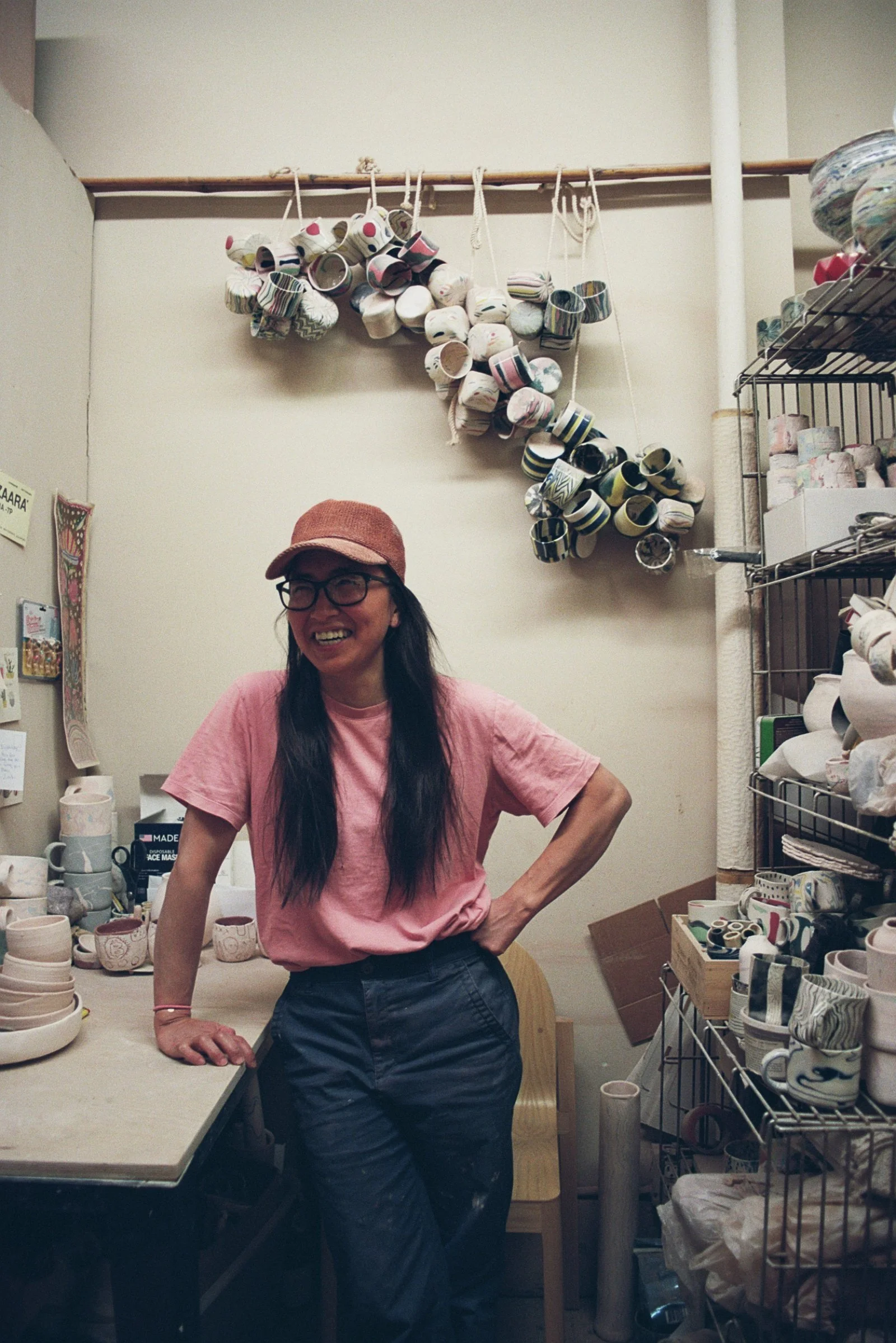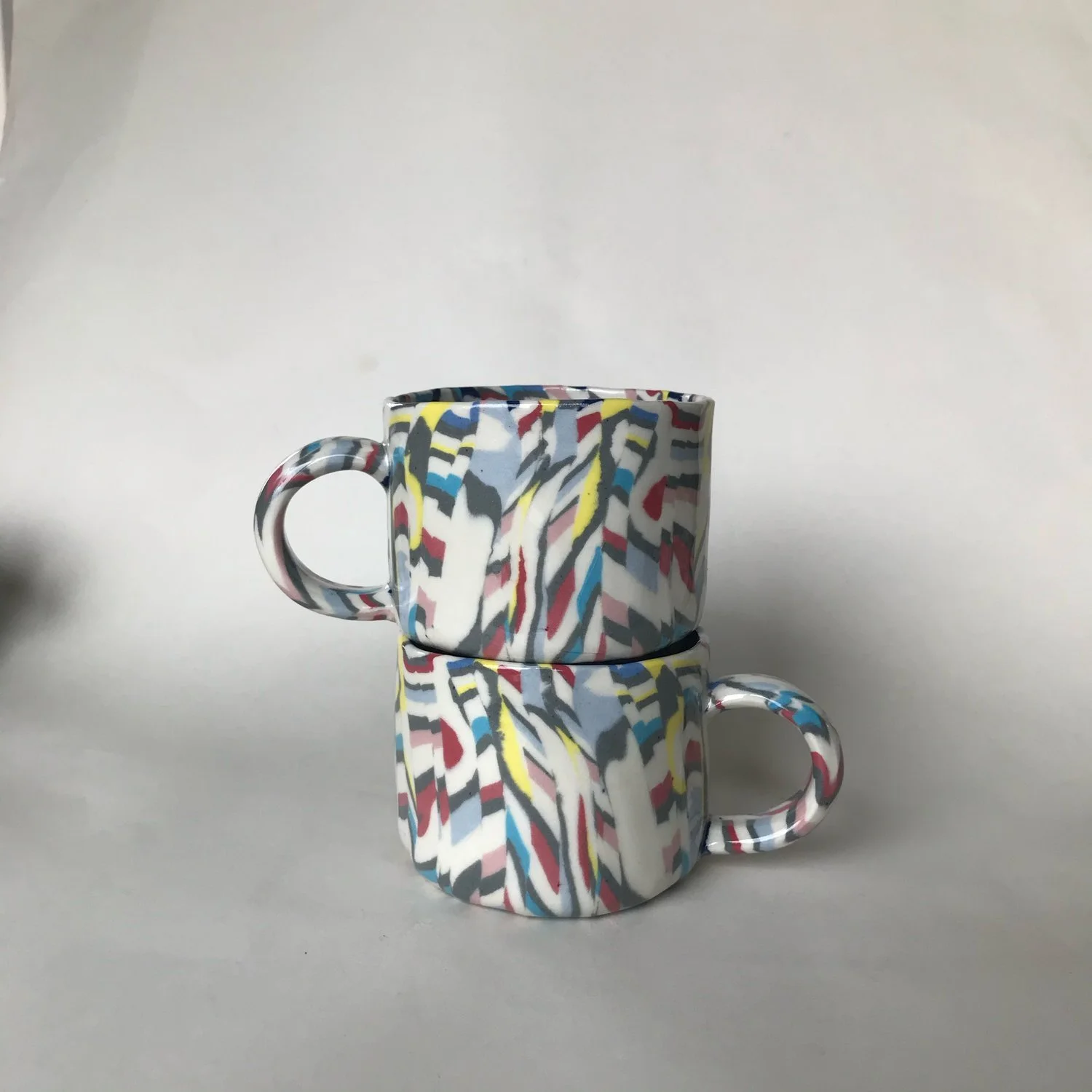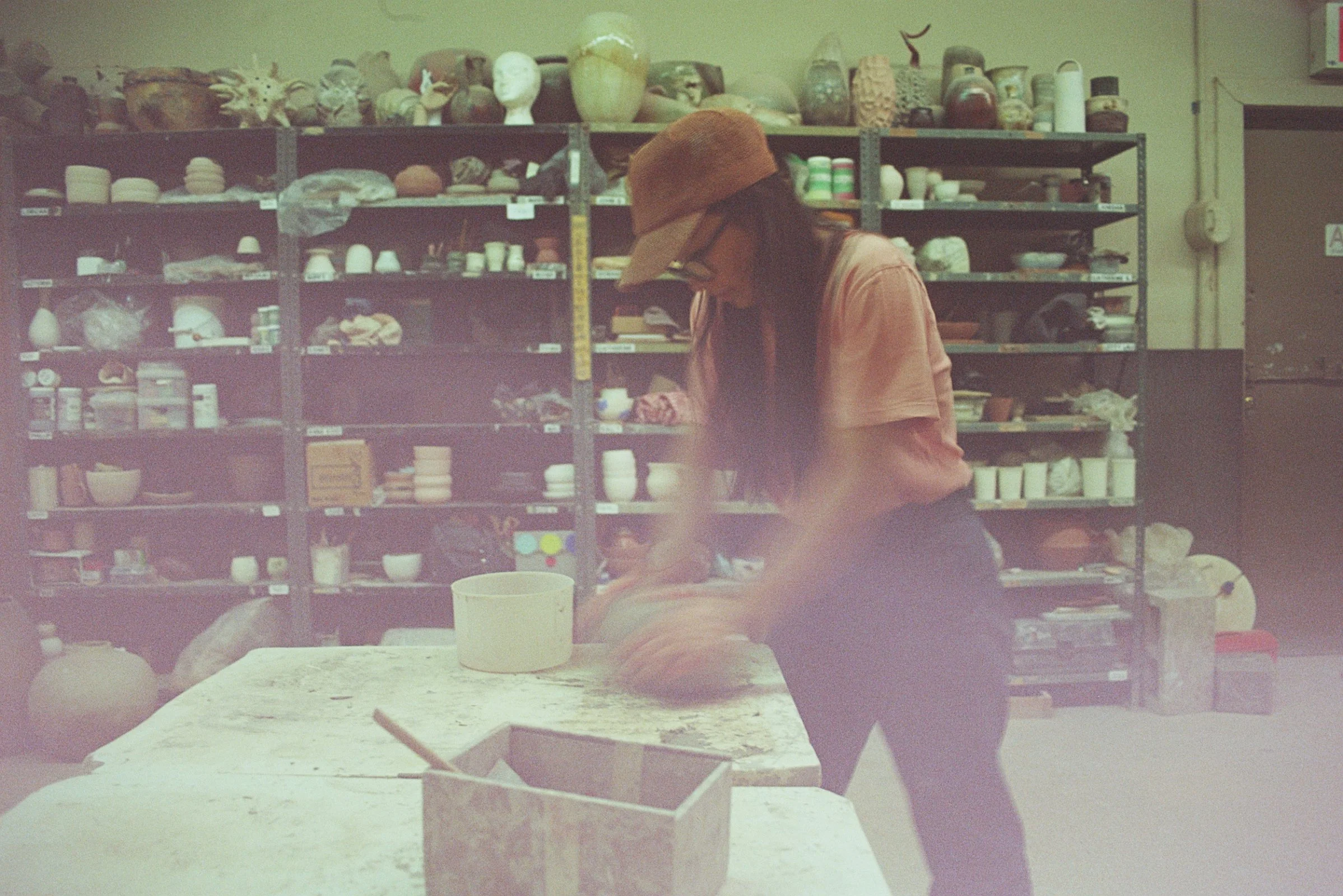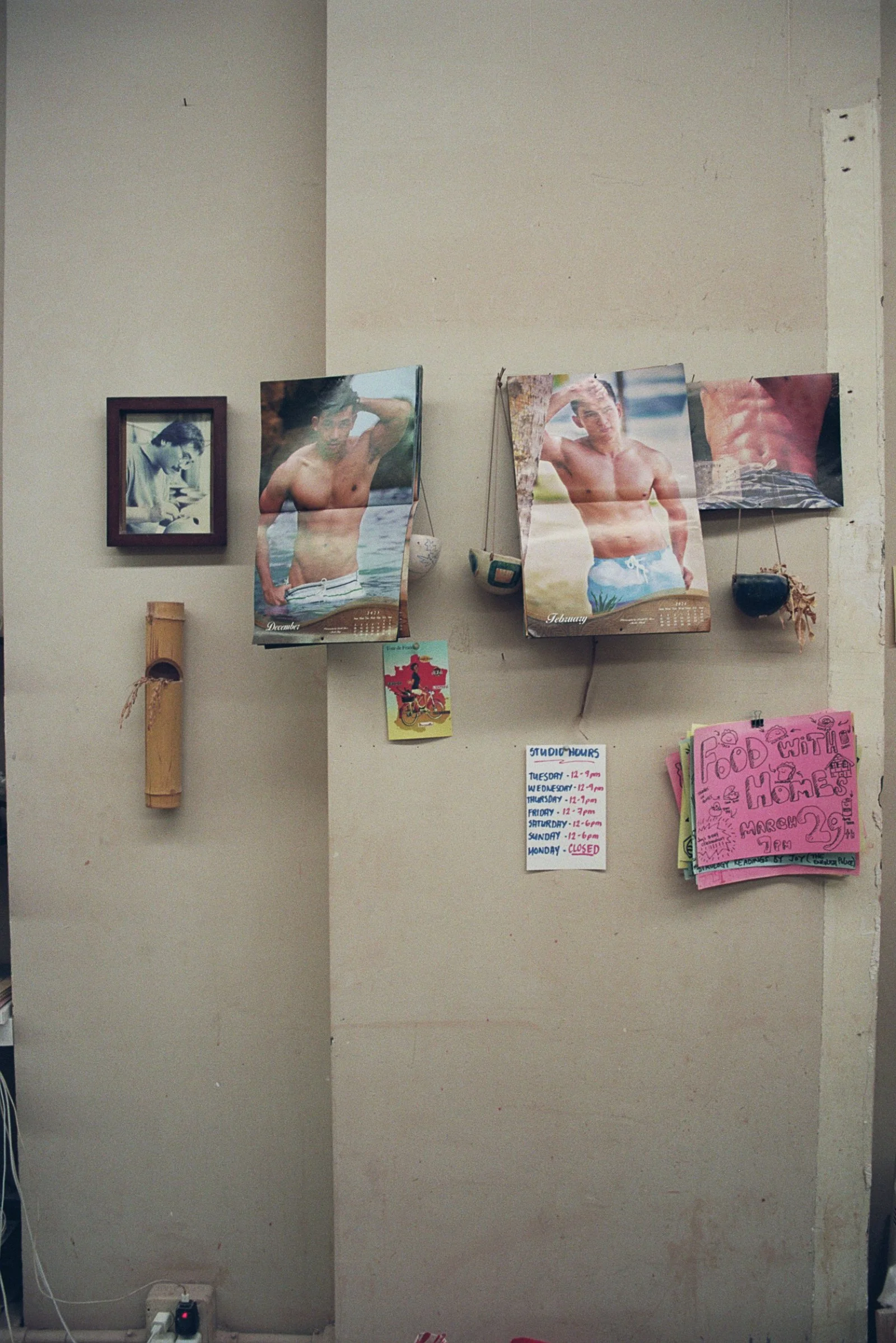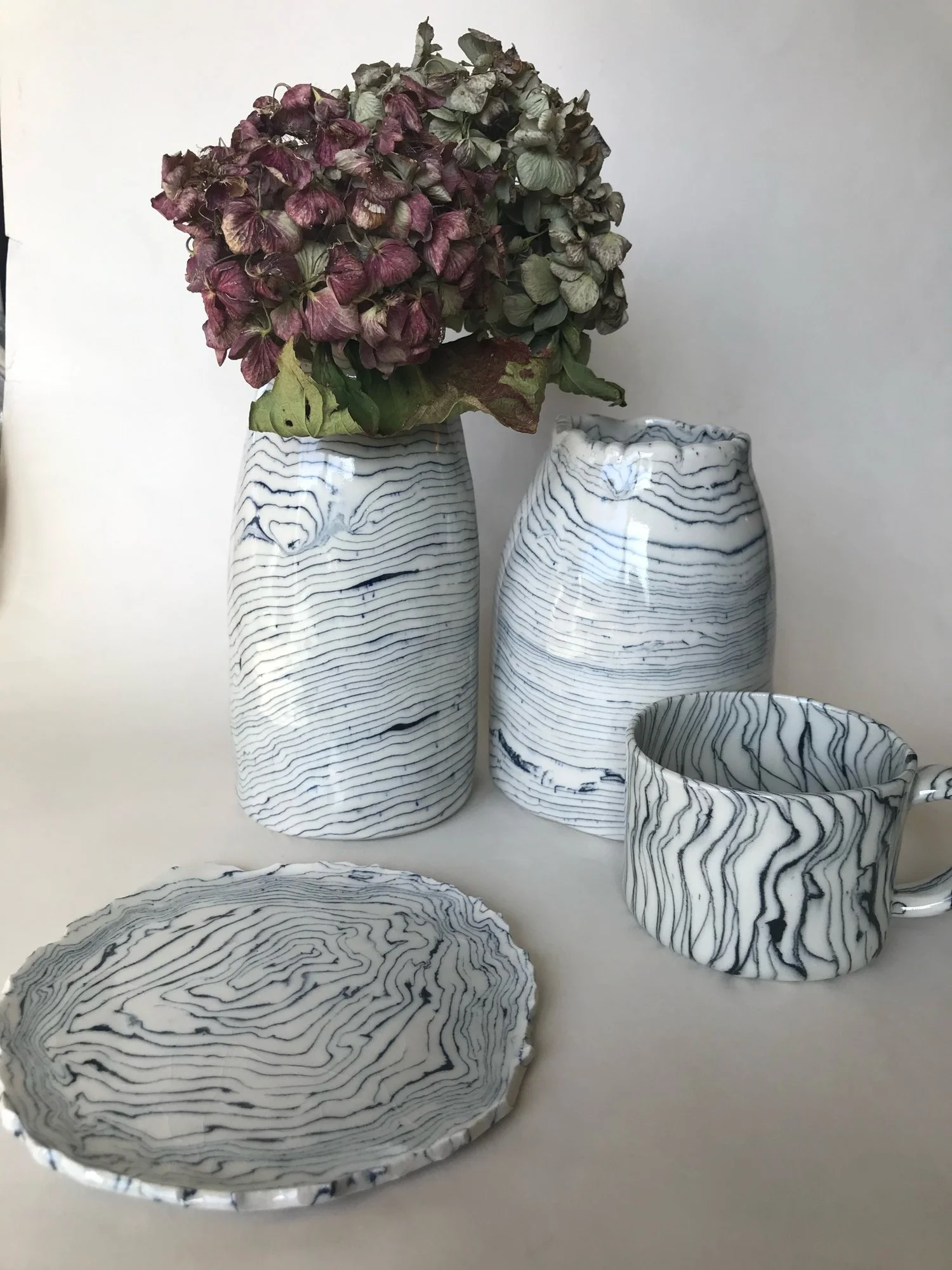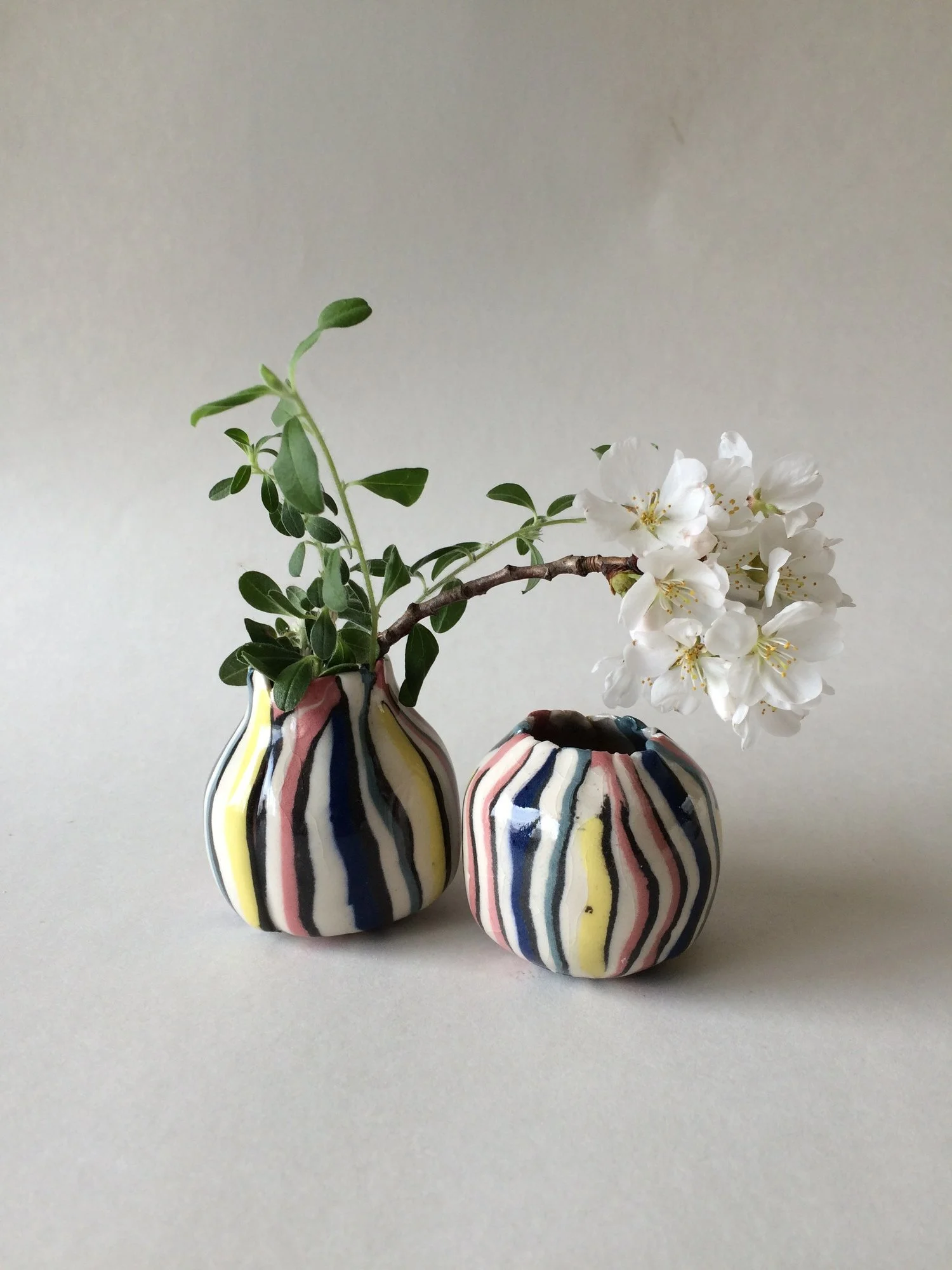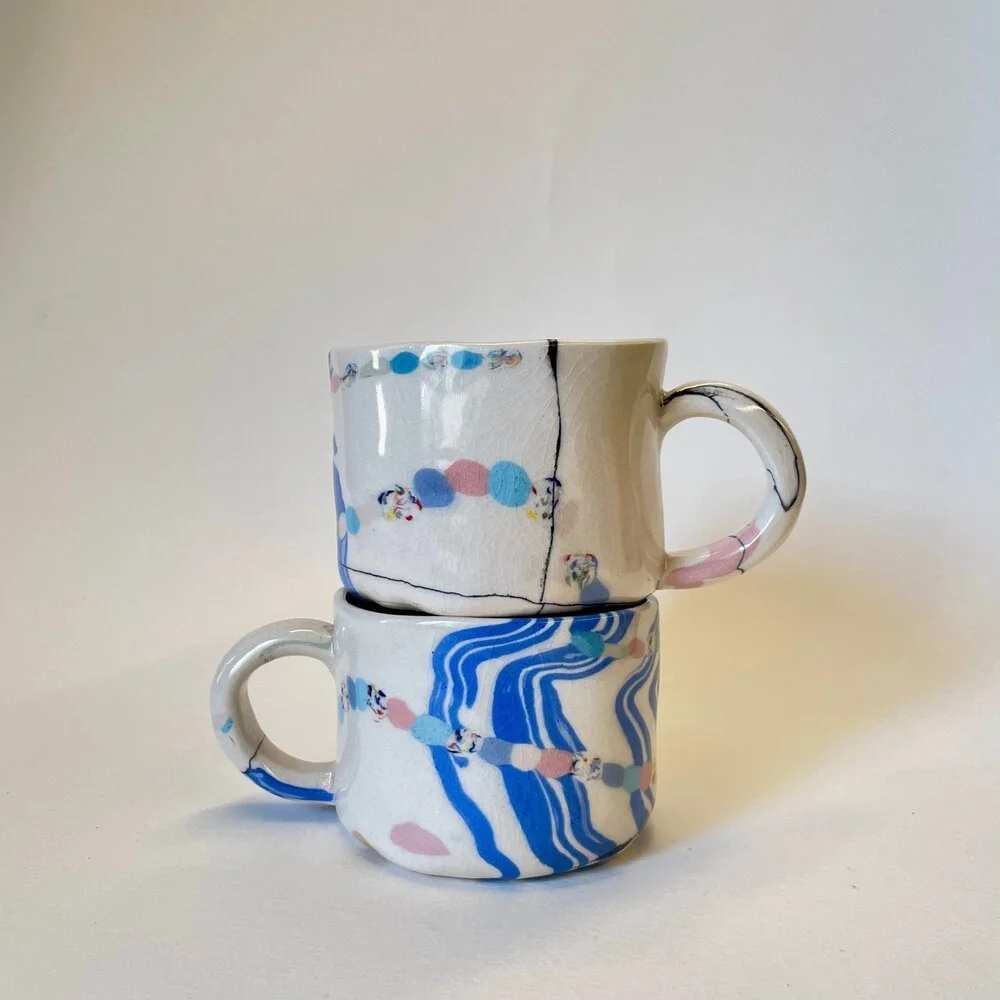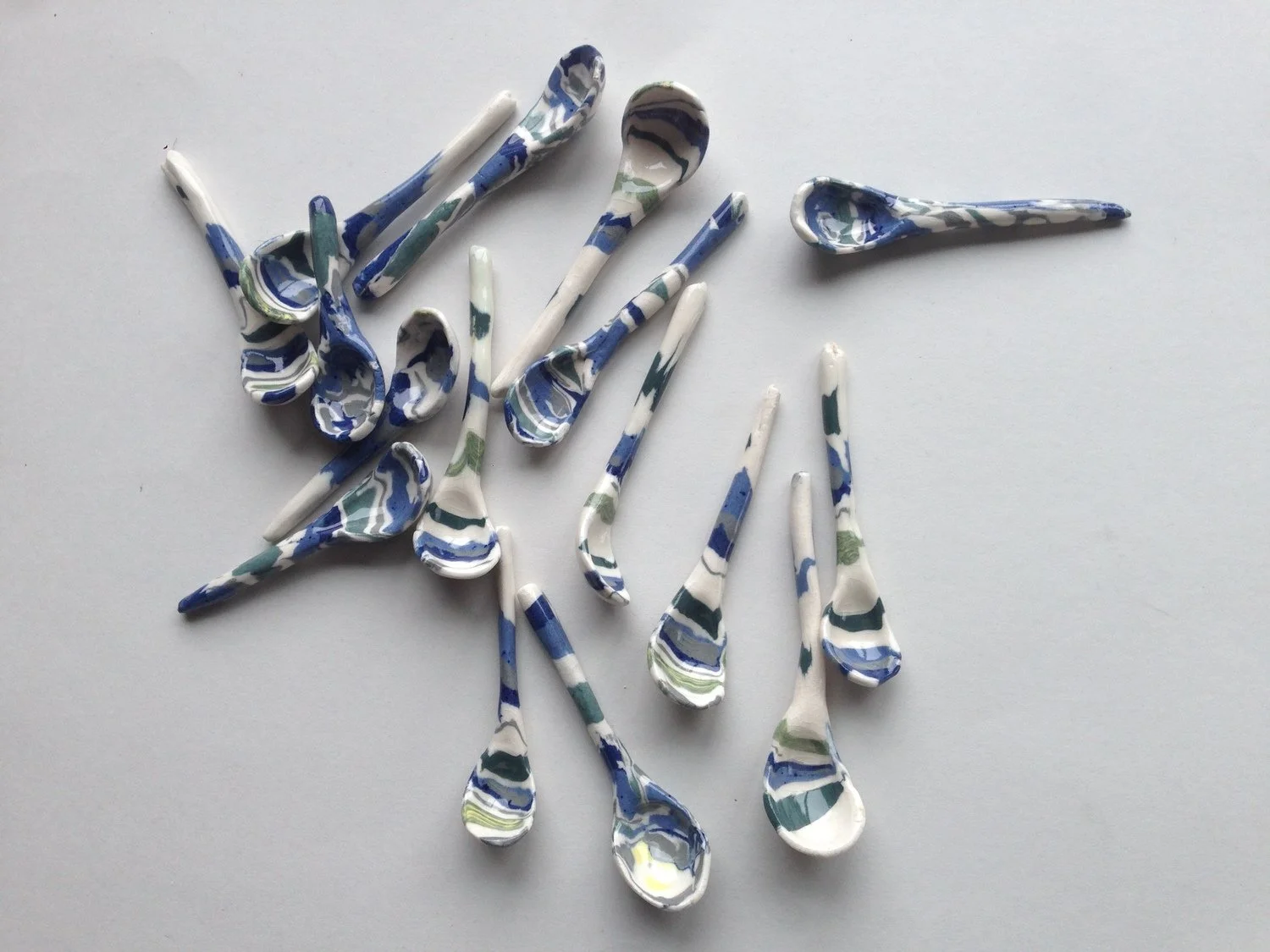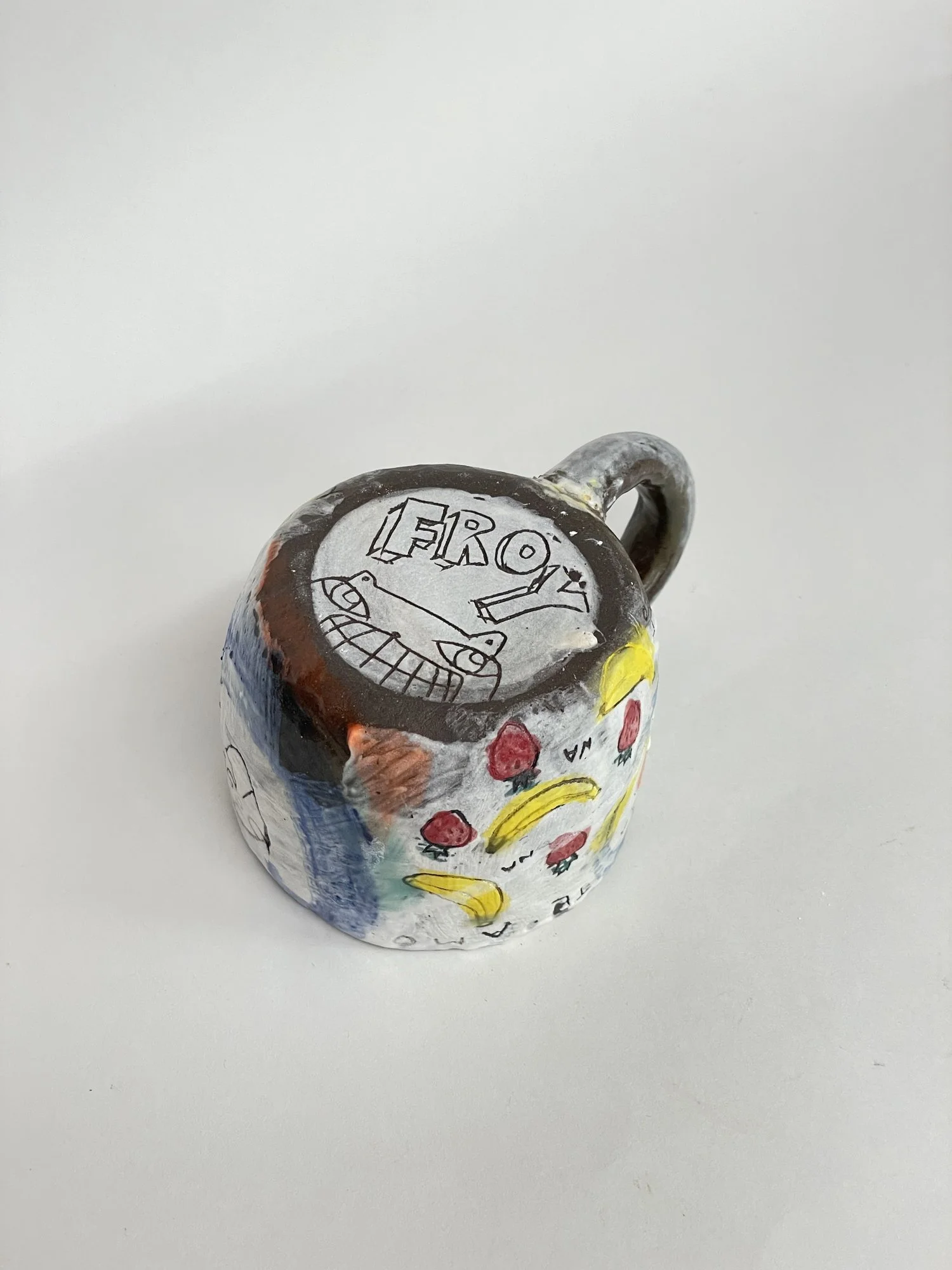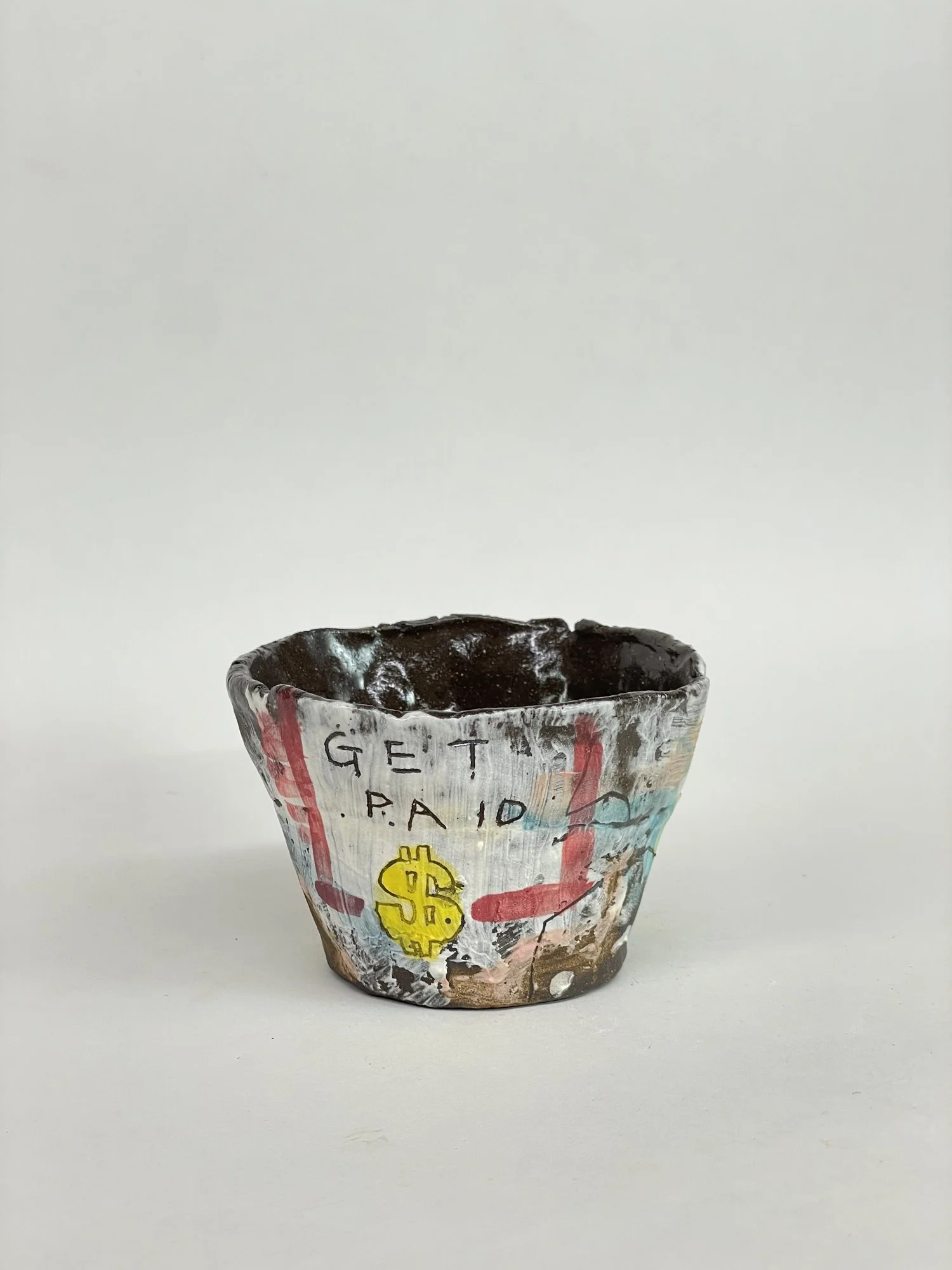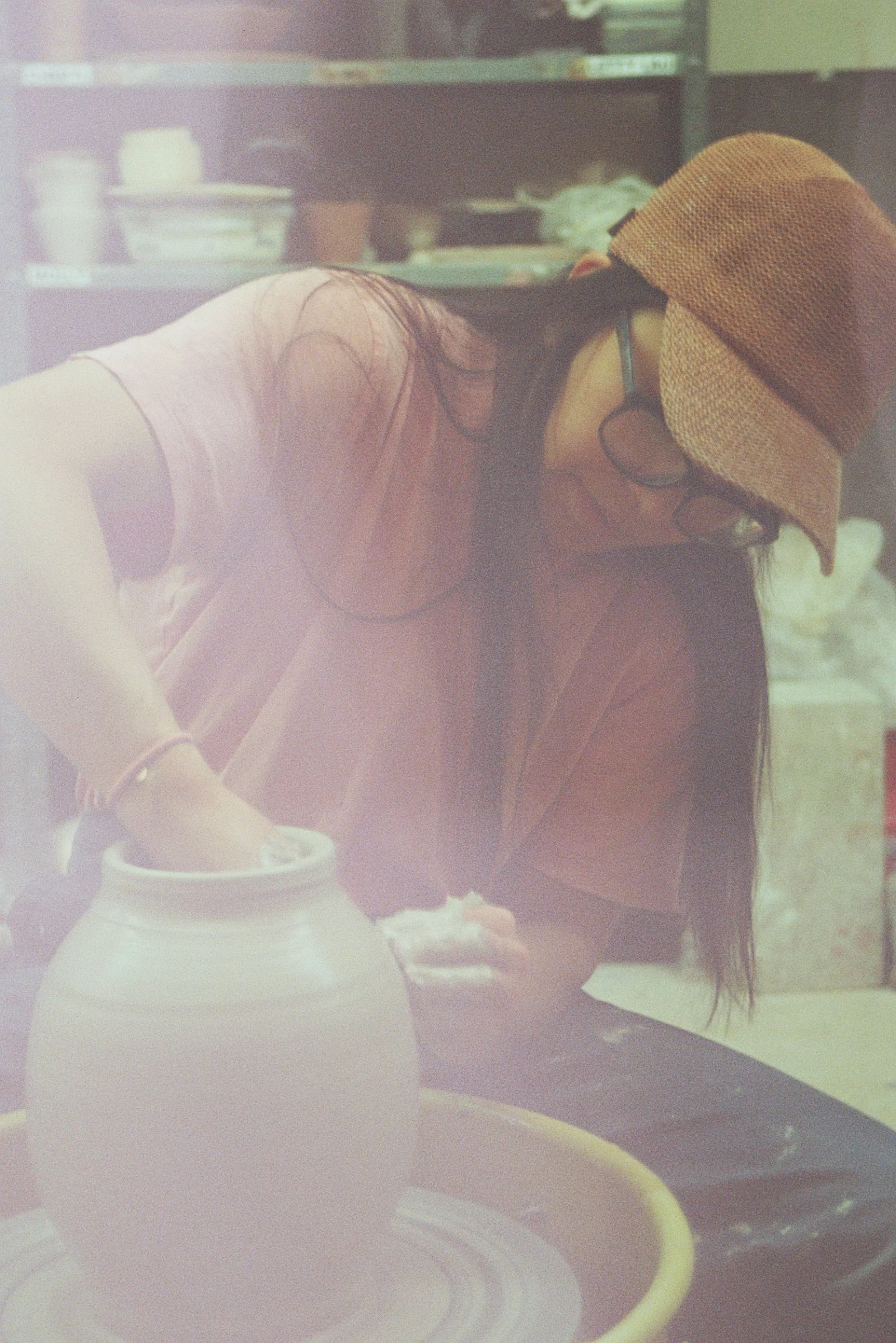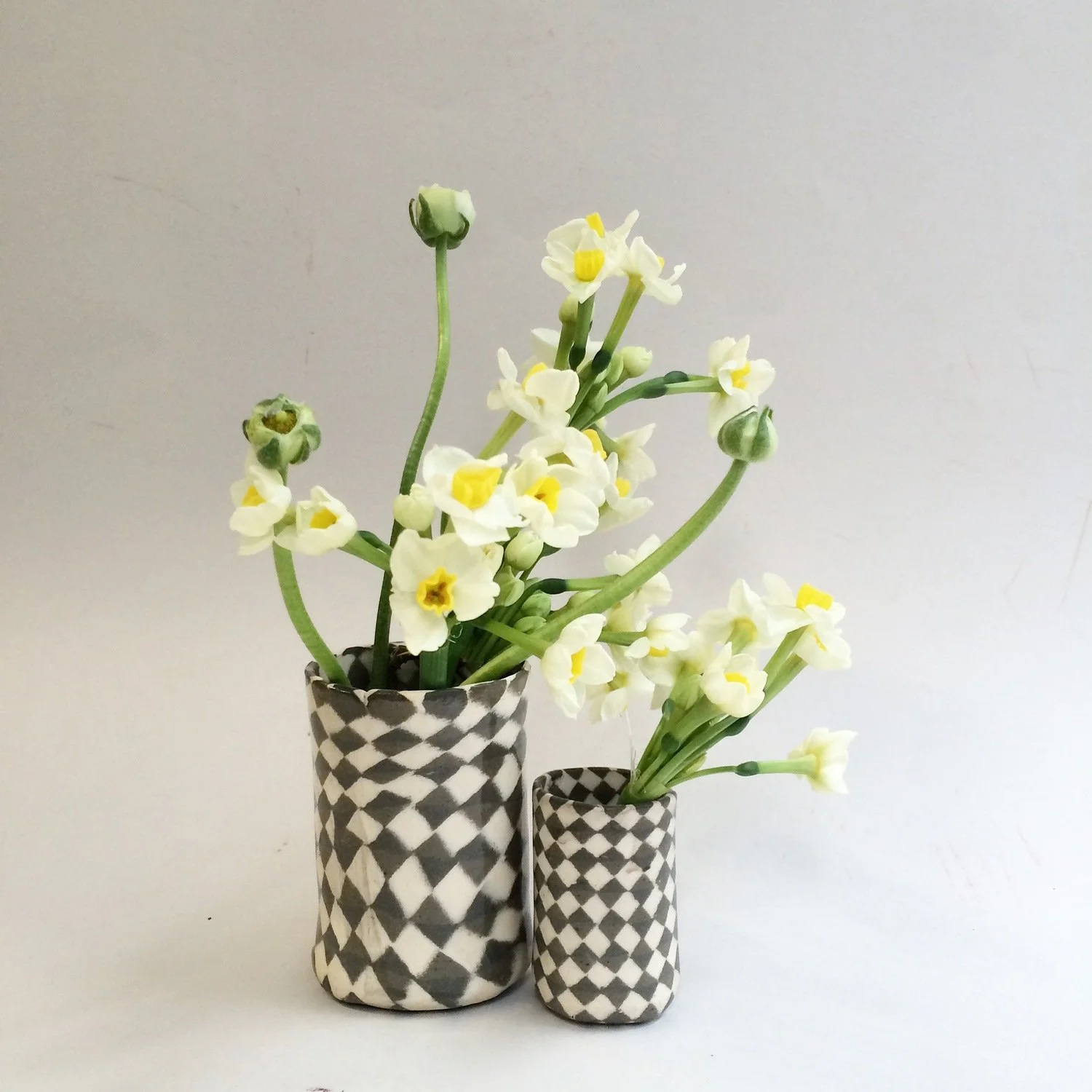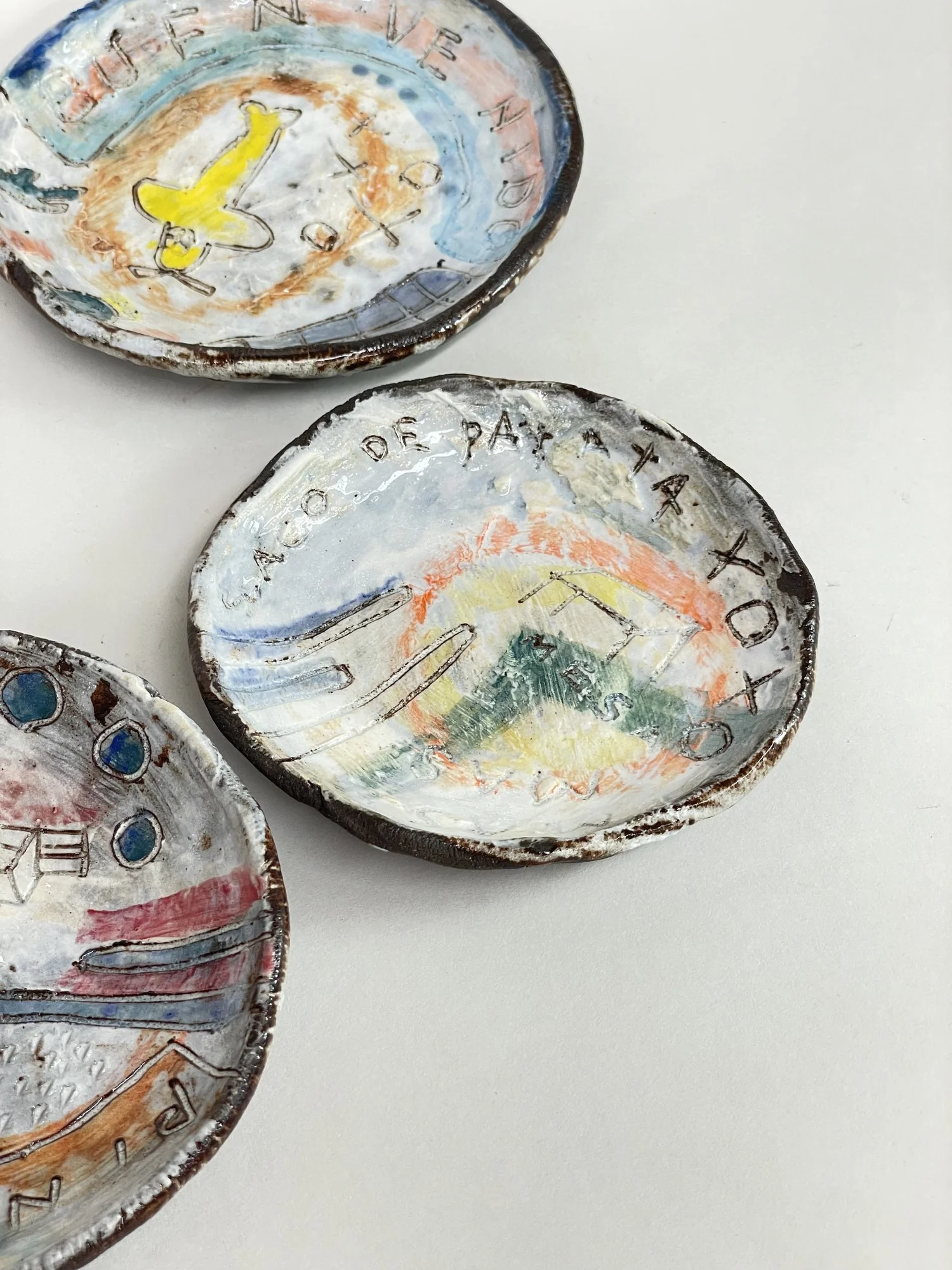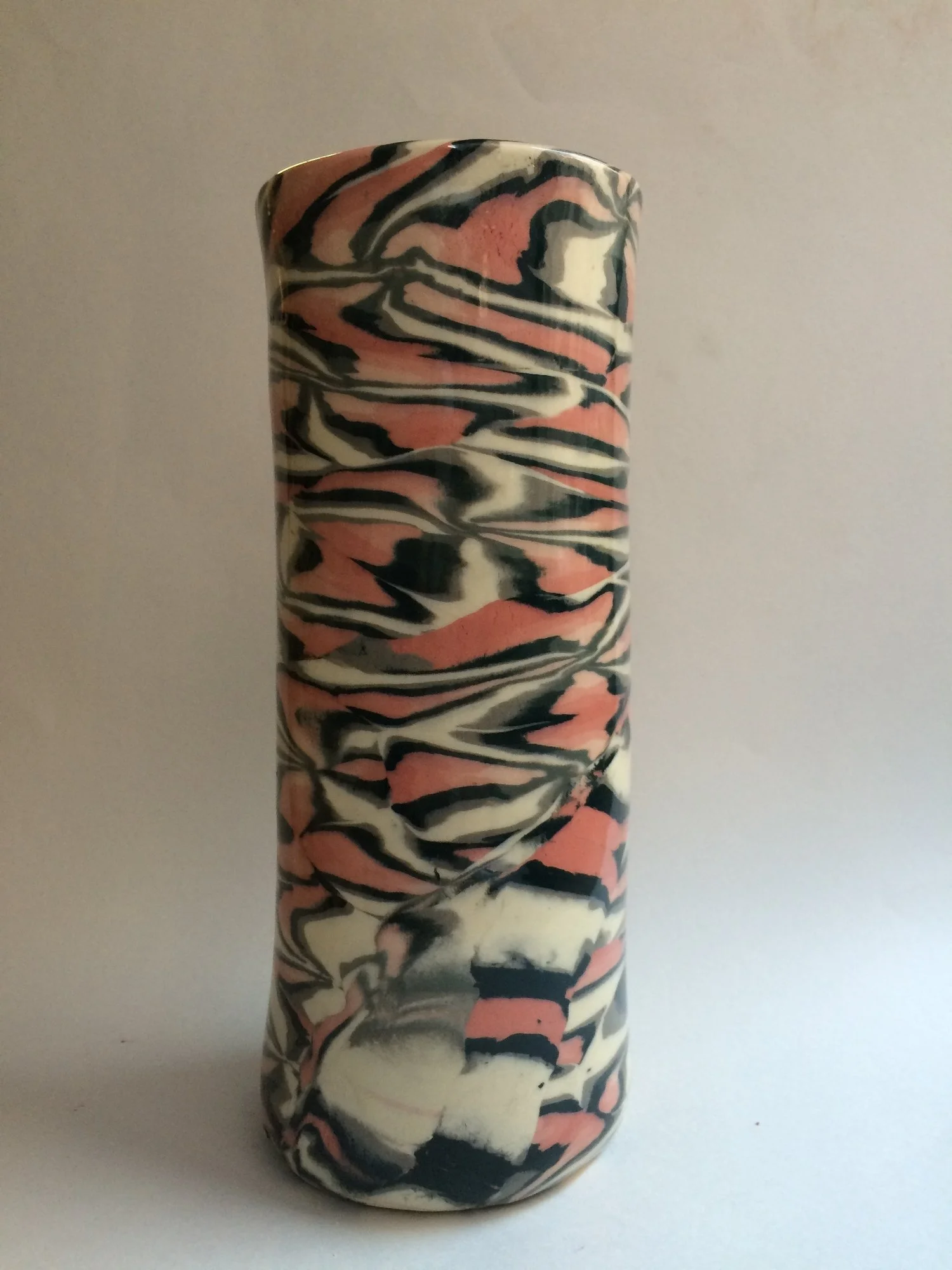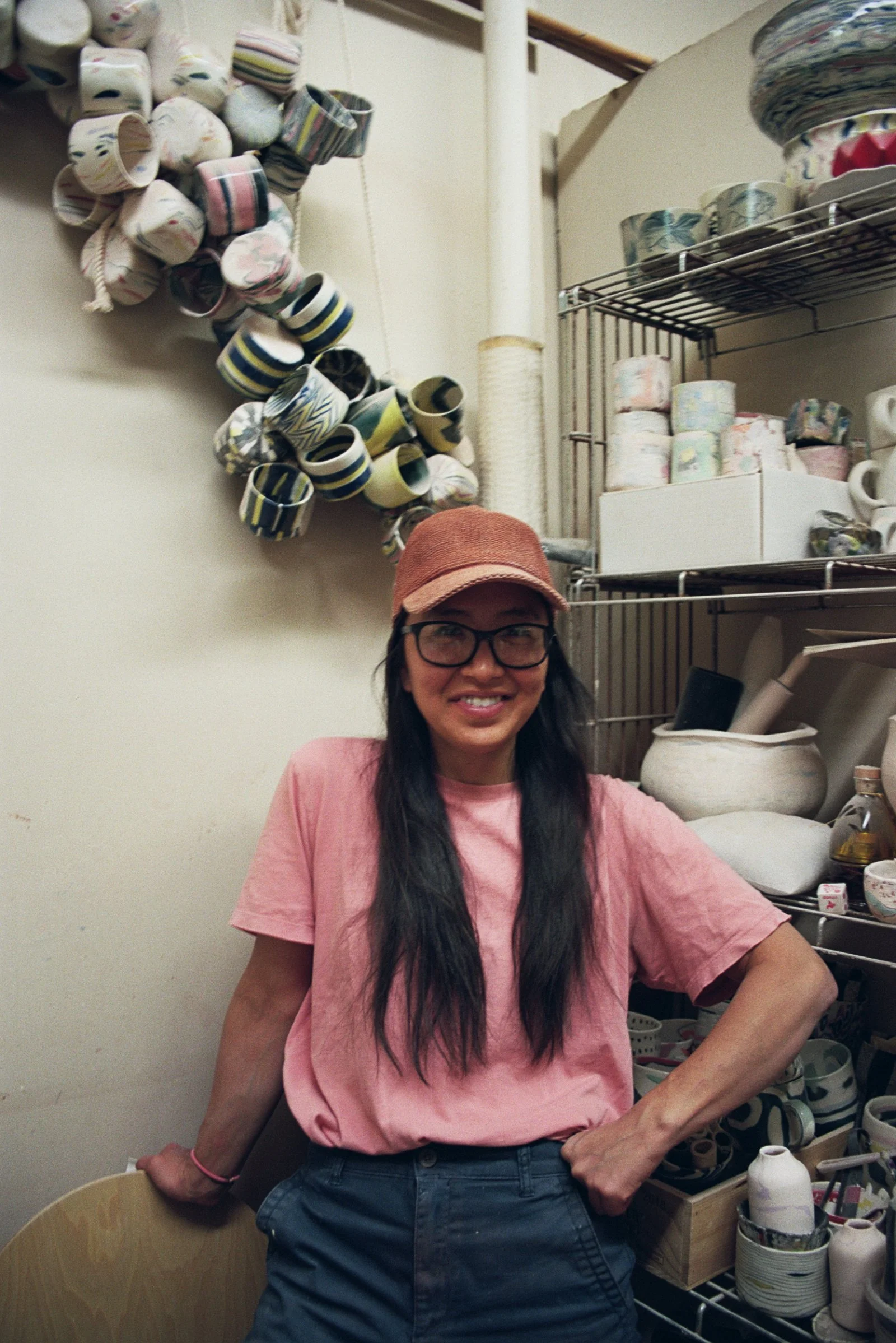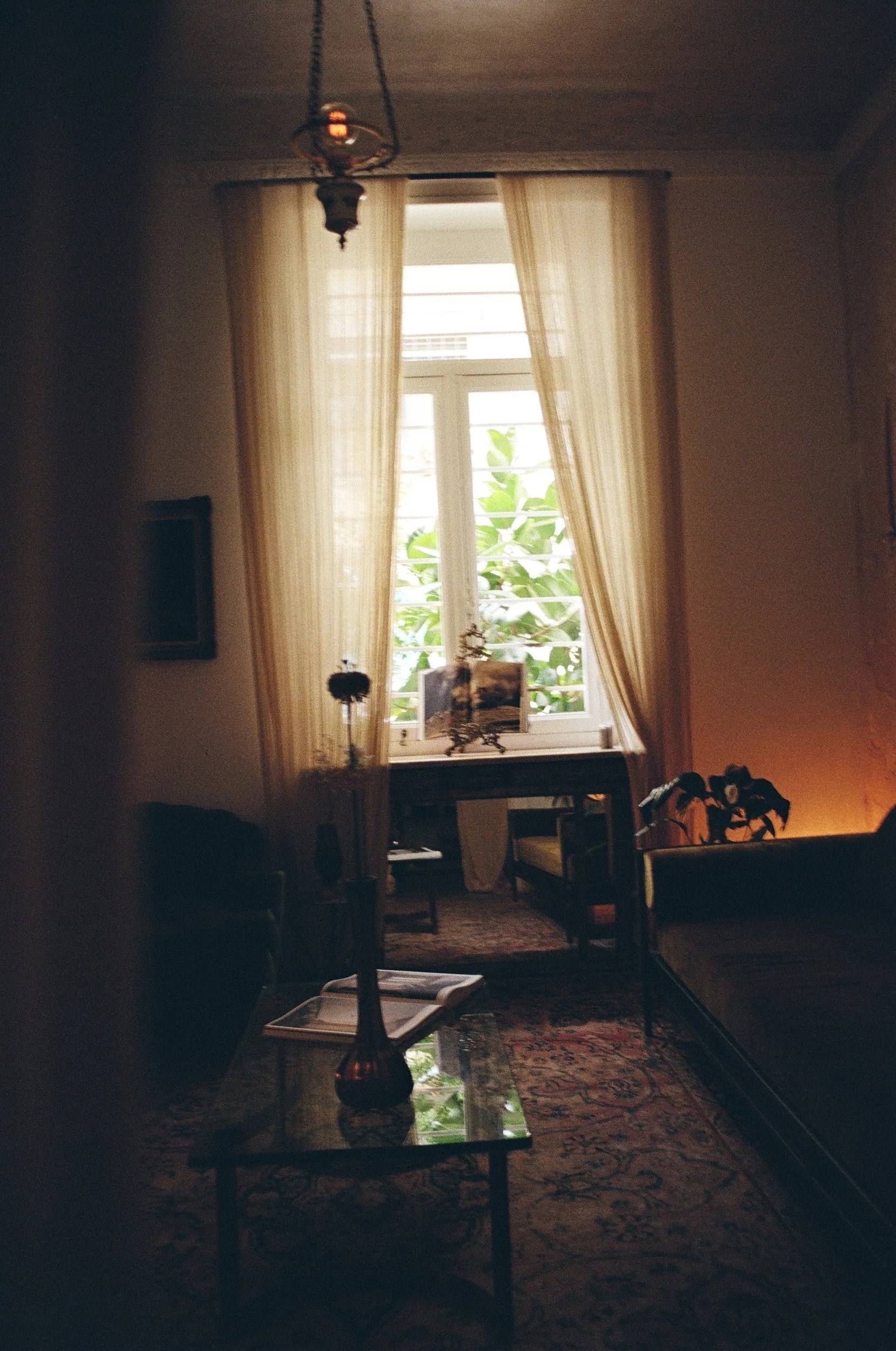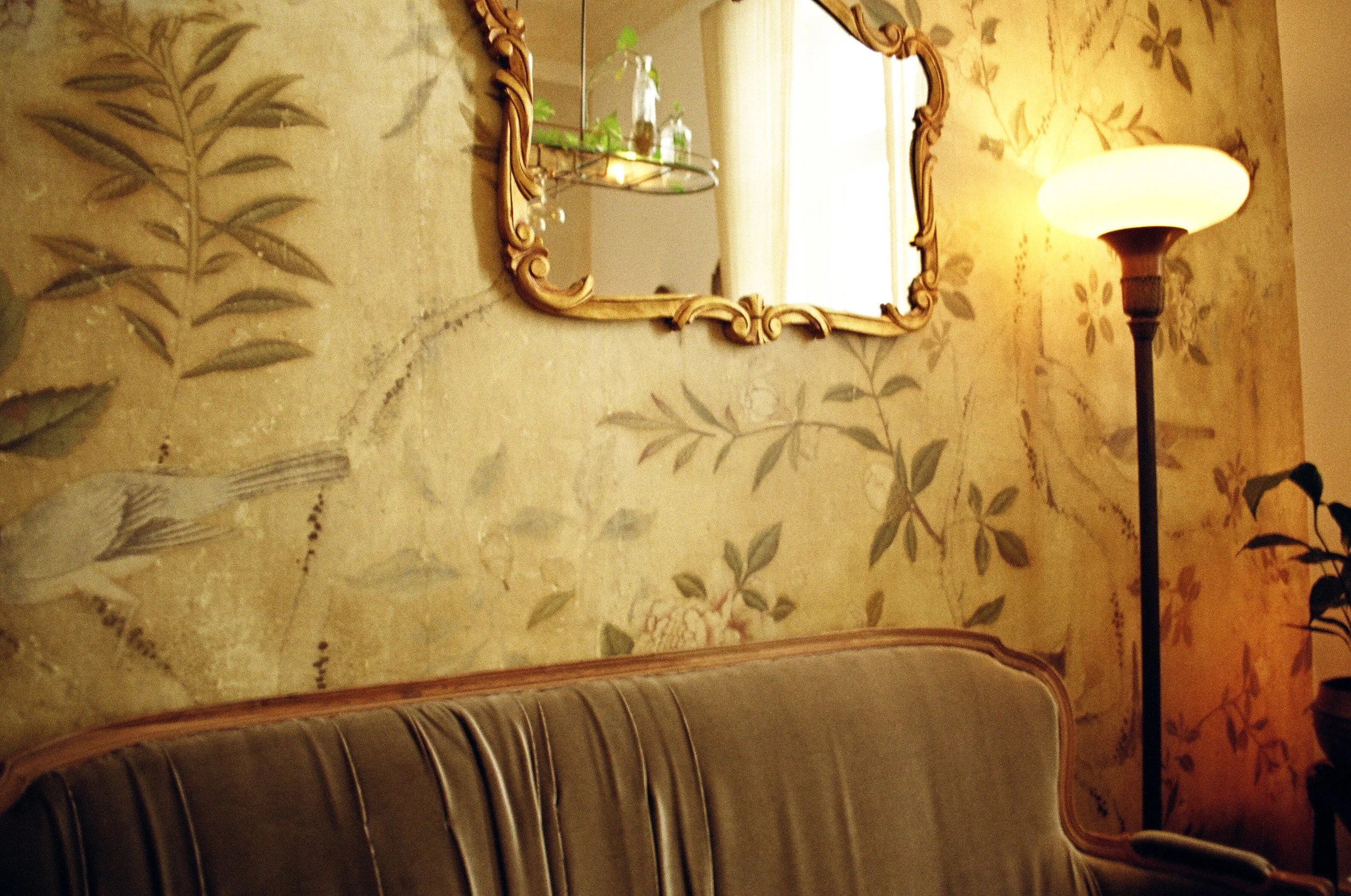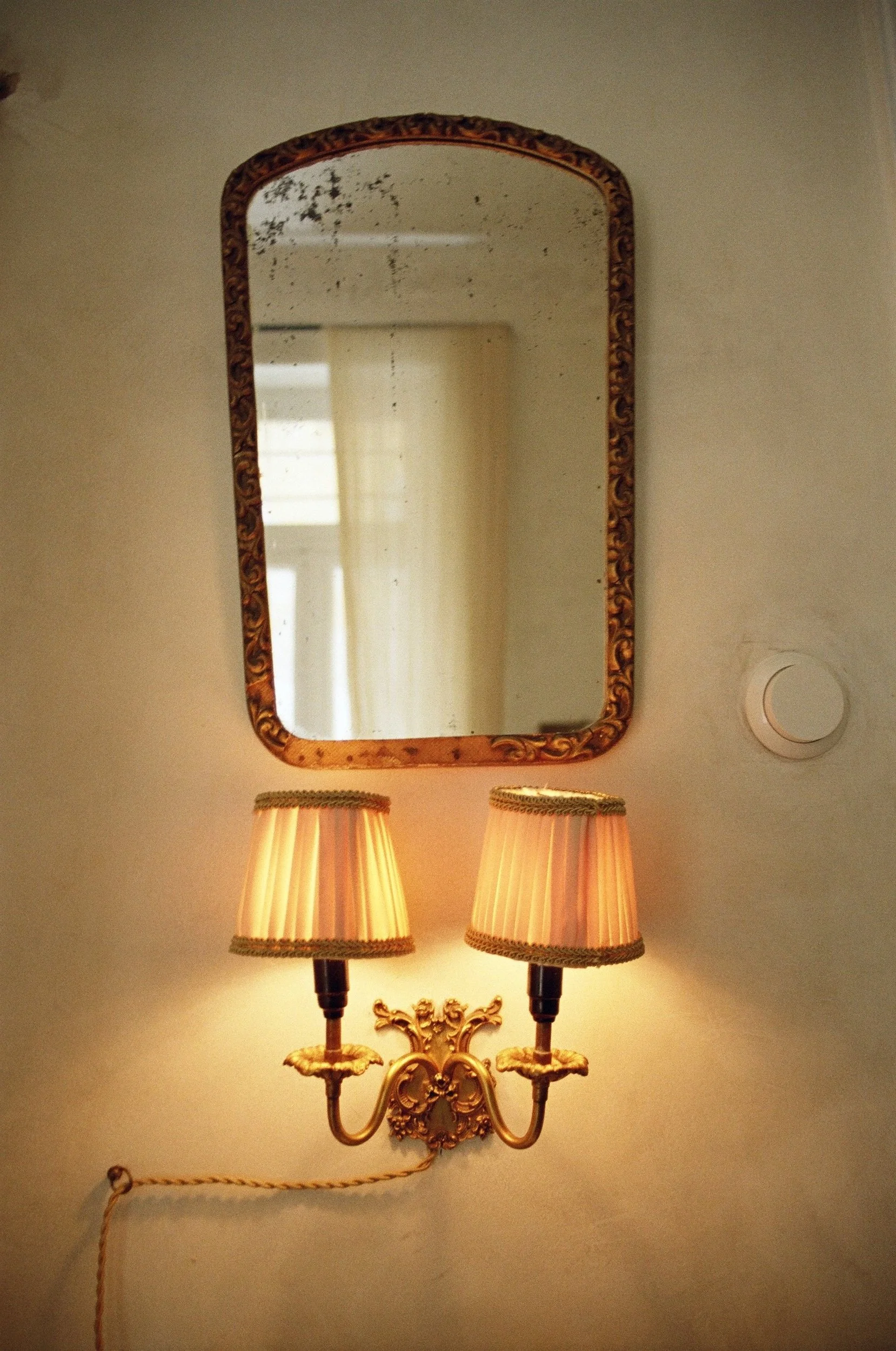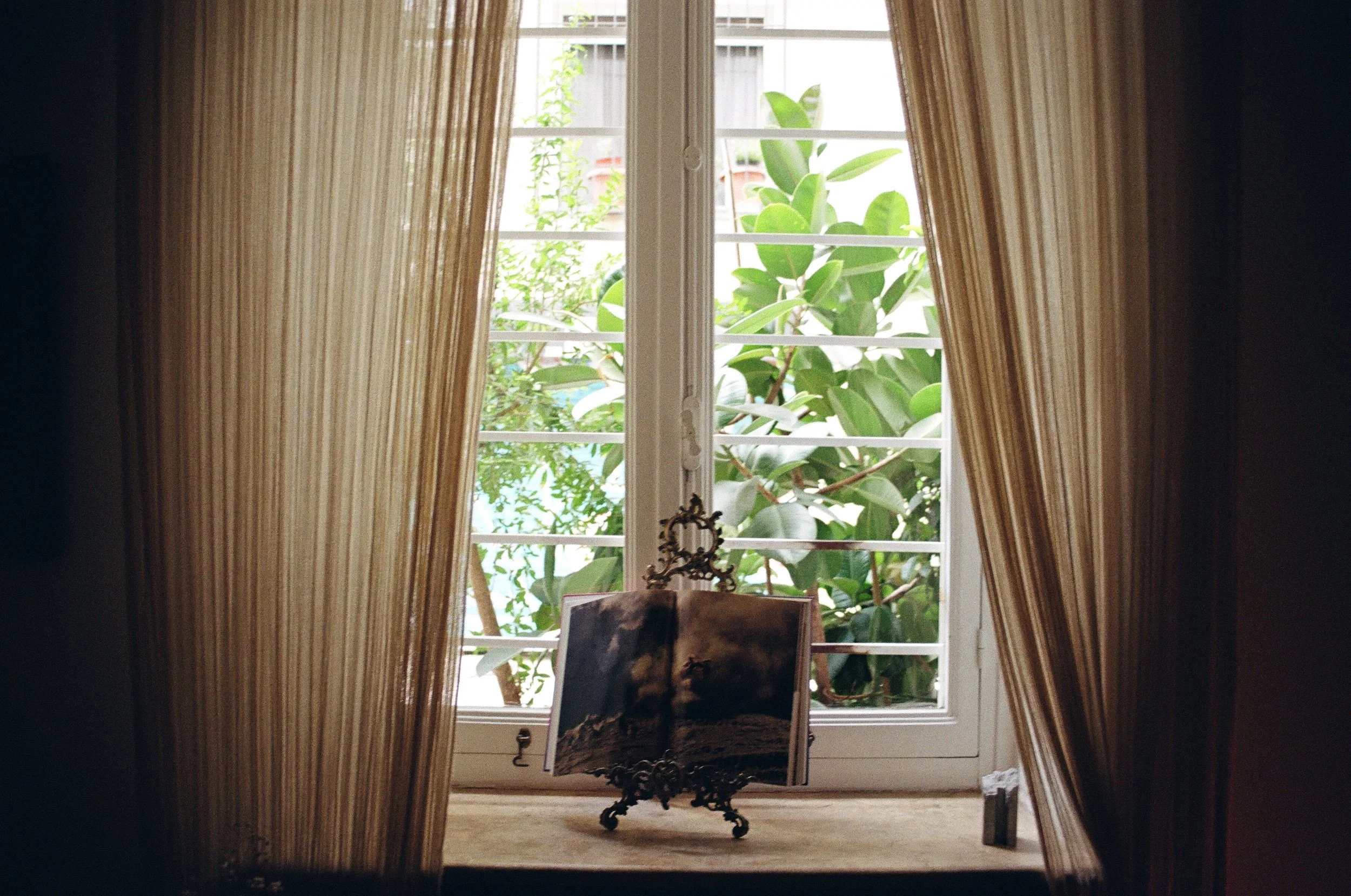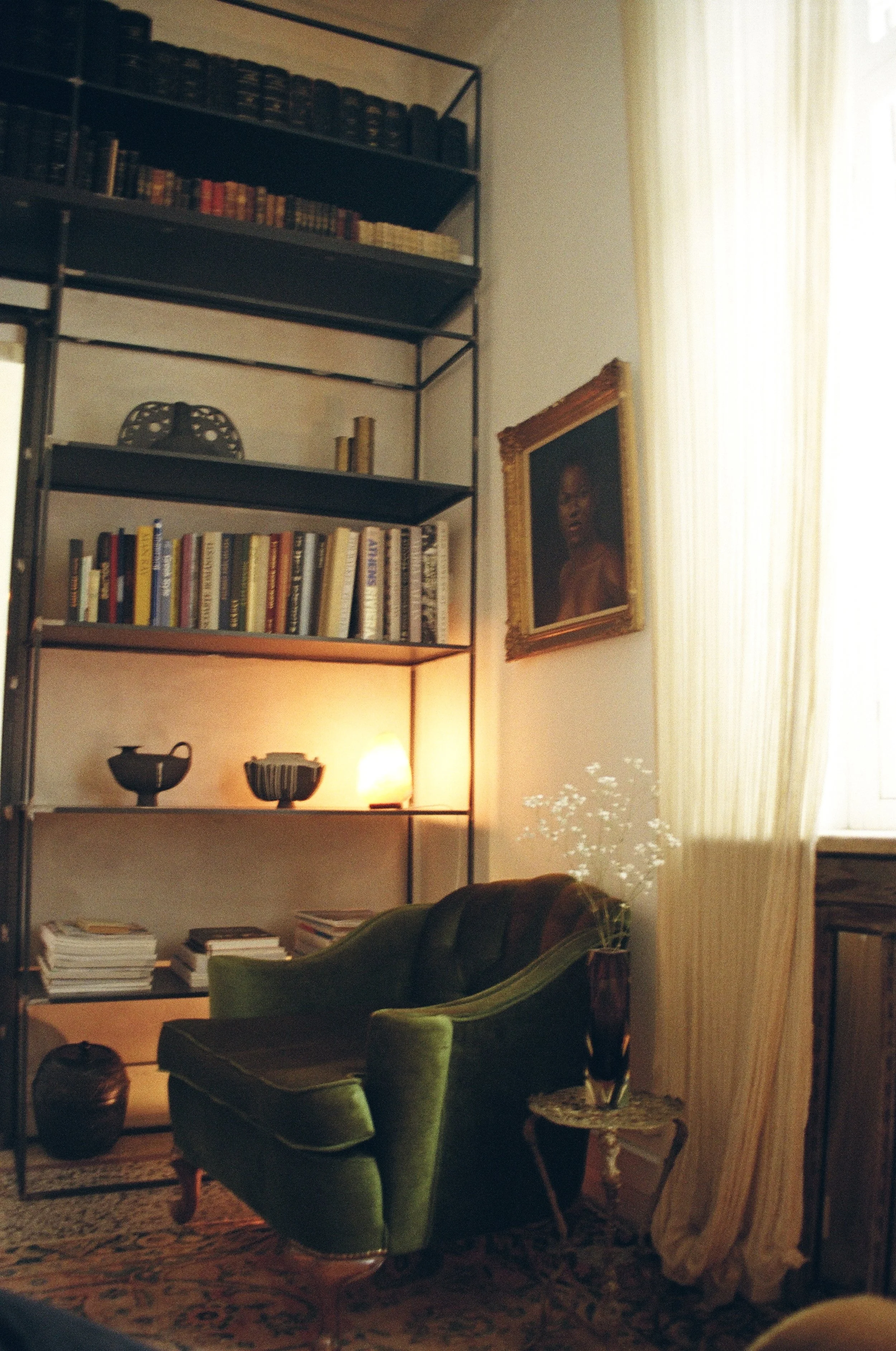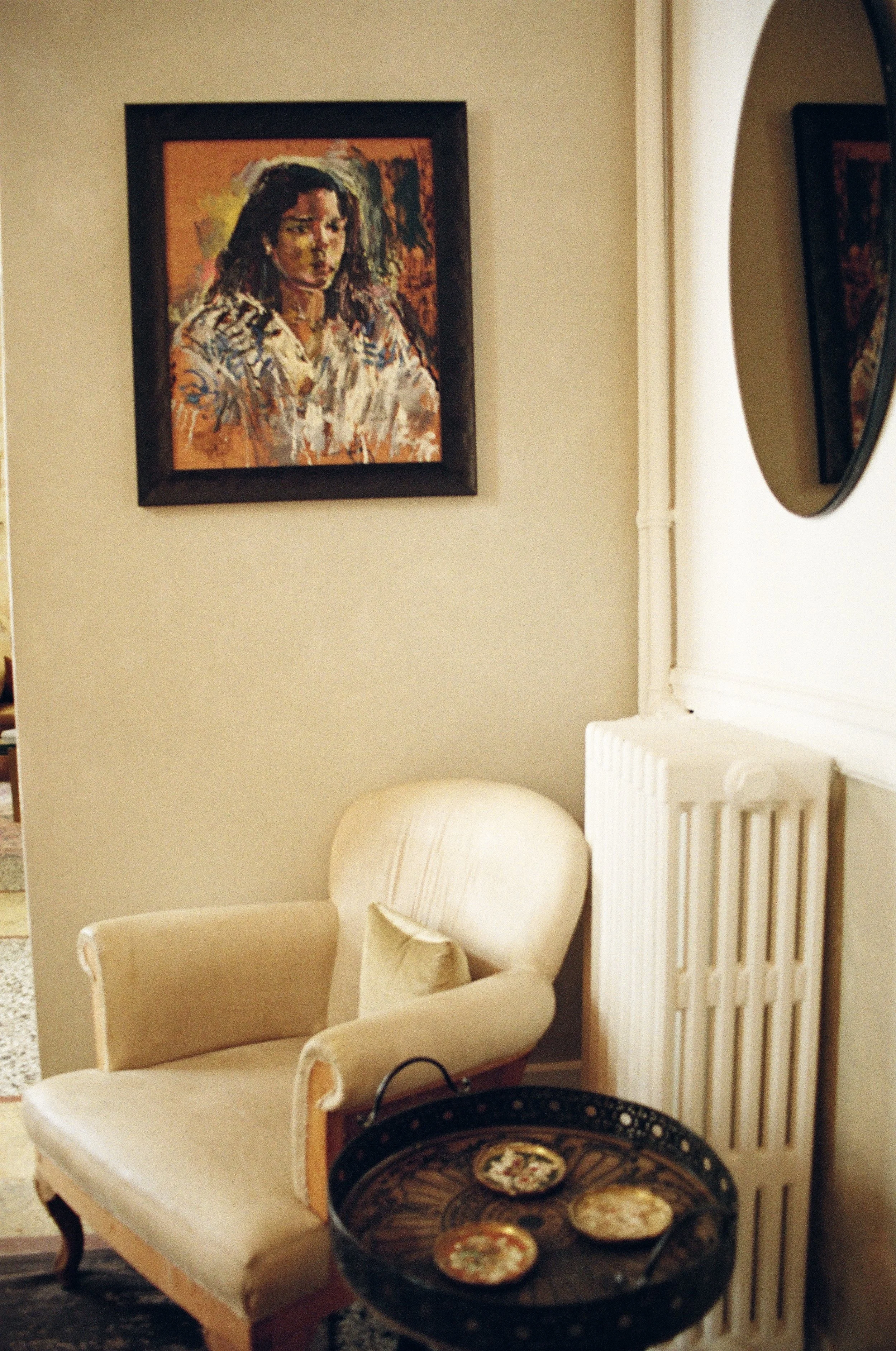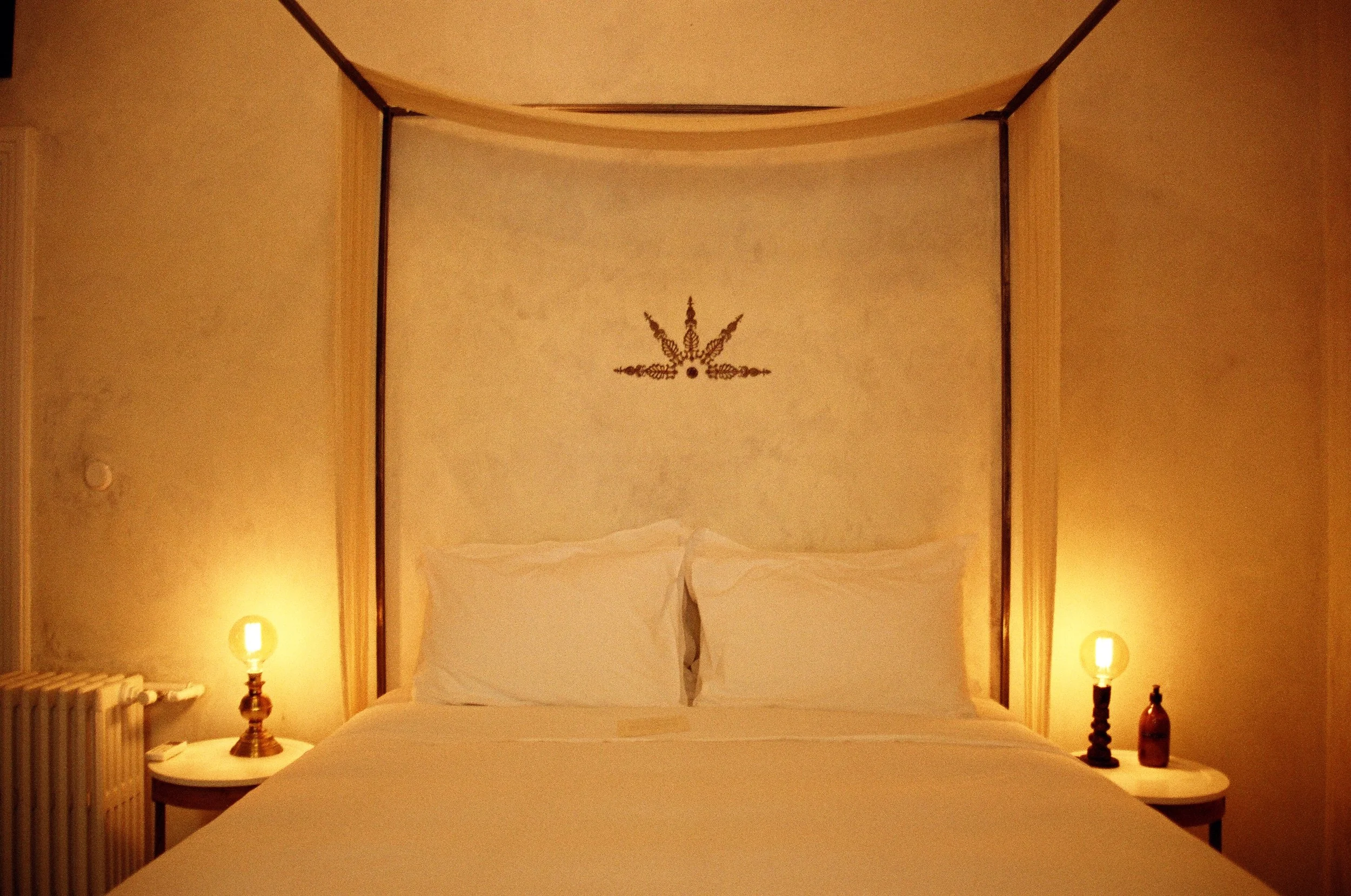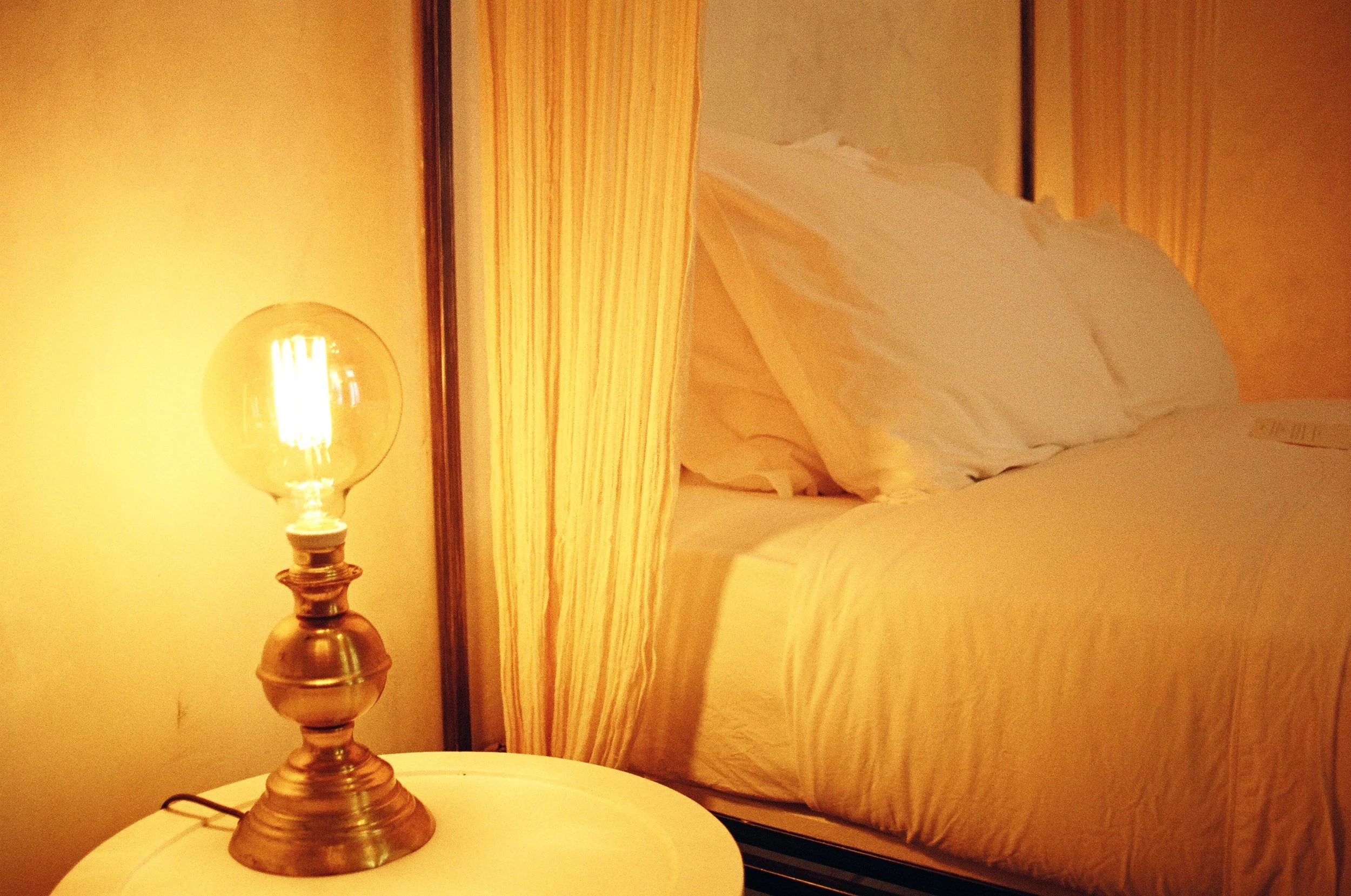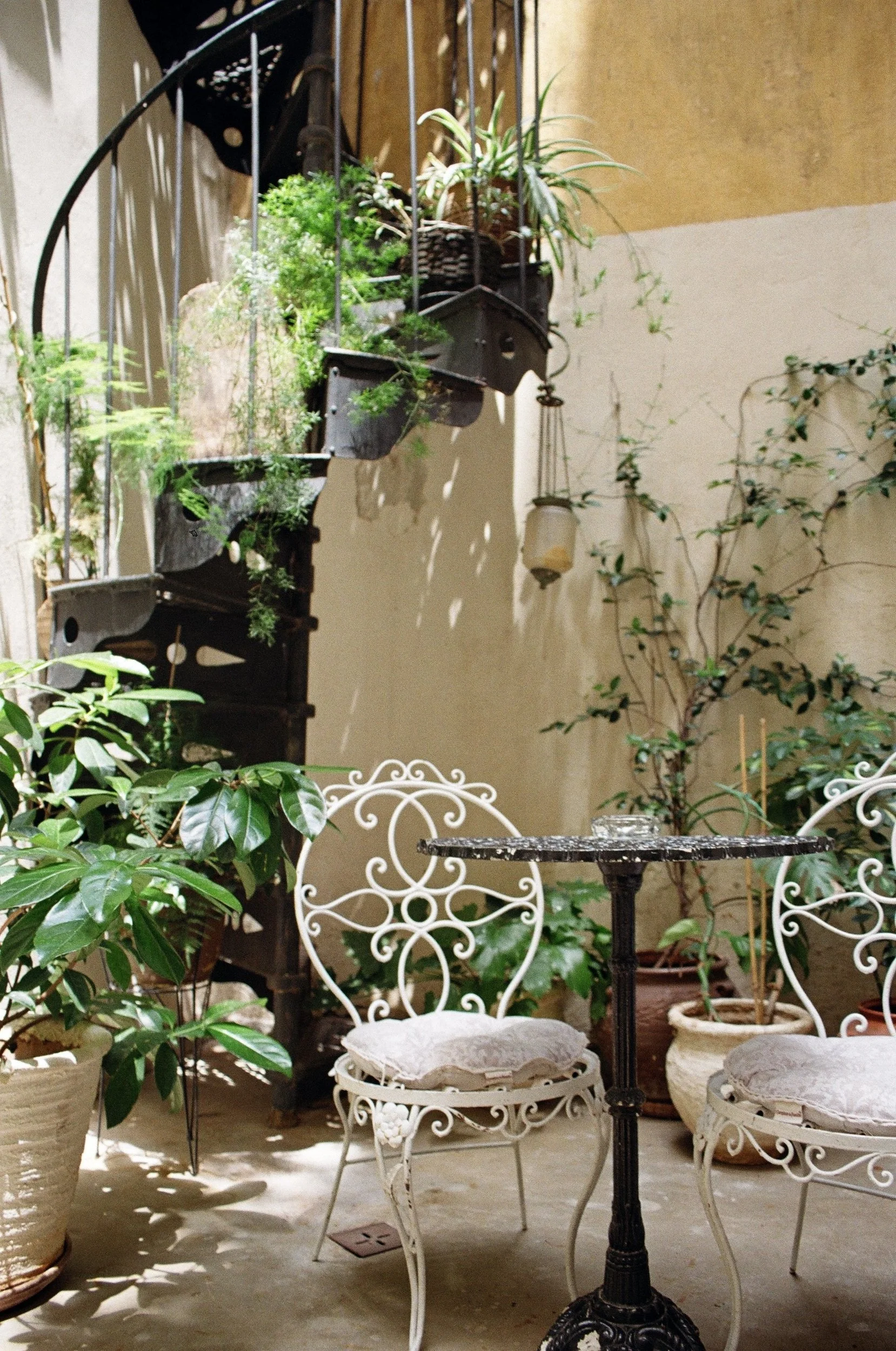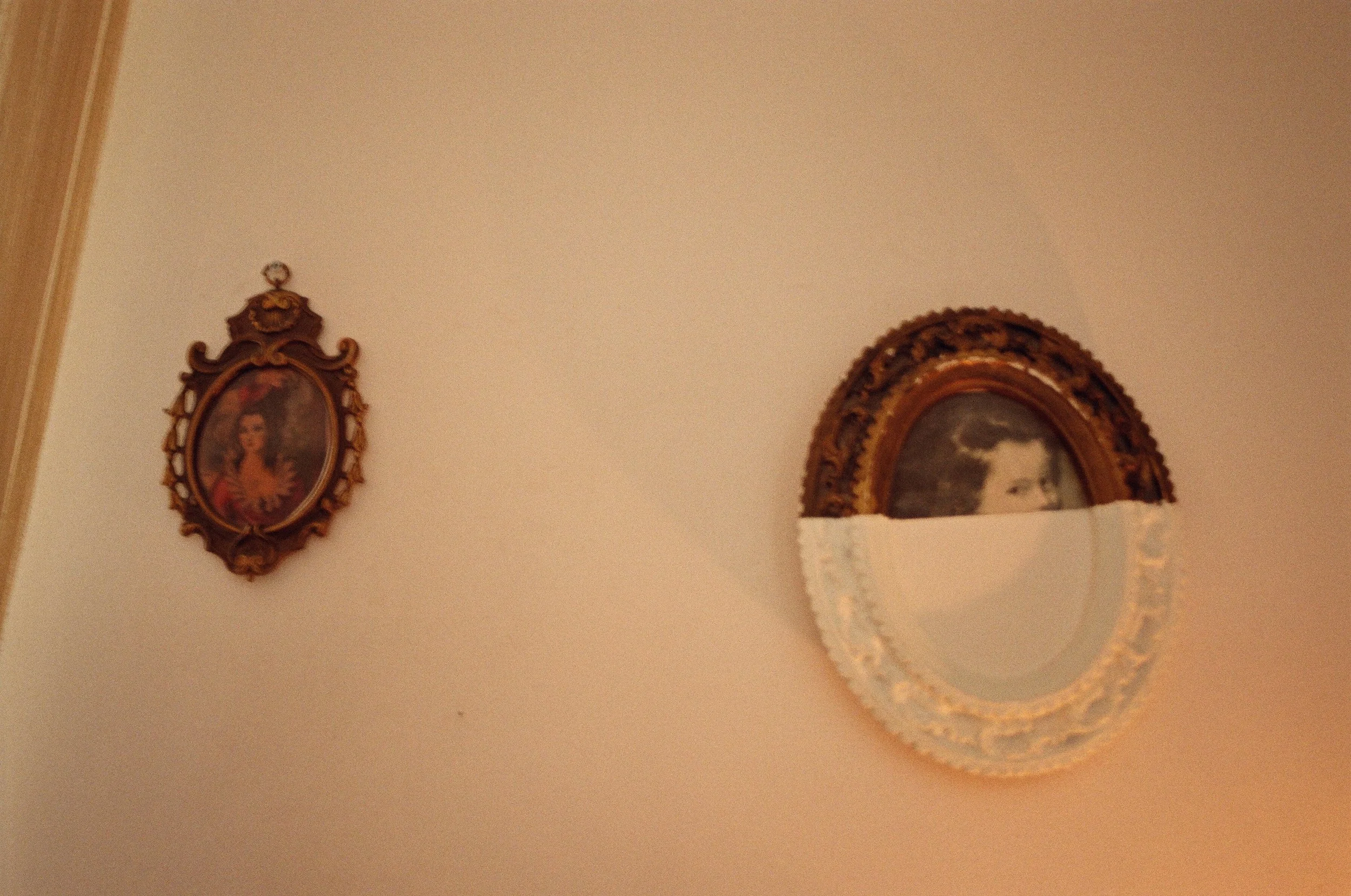in conversation with . . .
Risa Nishimori
Above: Risa Nishimori in the studio at Togei Kyoshitsu in Koreatown
Risa Nishimori is an innovative ceramicist and the second-generation owner of beloved pottery studio Togei Kyoshitsu in Manhattan’s Koreatown.
After her formal training in Japan, Risa returned to New York, where she developed her signature style that uses nerikomi in unconventional ways. The traditional Japanese technique involves cutting and stacking colorful clays to form patterned blocks and create marbling effects.
In addition to teaching wheel and hand-building pottery at Togei, and selling her designs under her own name, Risa has created a new immersion line, Froy, which marks a departure from her modern interpretation of nerikomi by exploring humorous decorative themes.
Her pieces can be found at concept stores around the world, including in Australia, Canada, Hong Kong, Sweden, and the United Kingdom.
Keep in touch with Layla:
Instagram
@risaasama and @nytogei
Website
www.risanishimori.com
Words by: Tina Iasonidis
Photos by: Tina Iasonidis, unless otherwise noted
Interview recorded:
In your own words, who are you, and what do you do?
I would say I am a ceramicist. But recently, I think I’ve been feeling like more of a business person. What do I do . . . I’m trying to navigate running a business in current New York. That’s not a very good answer.
Why design?
Part of it is that it was the family business. So it was a little bit already ingrained. At the same time, looking at traditional Japanese ceramics was very boring to me, and it’s what my parents did. It’s supposed to be subtle, quiet, very peaceful, serene, shit like that . . . So then I picked up a book about how to color clay. I thought that was kind of cool. It was very colorful, kind of in my style. It was more colorful than I was used to. I really enjoyed that, and I tried to do that by myself without the help of or the influence of my parents. I thought it was very different from what Japanese ceramics look like.
I did a little bit of research before the internet was really popular, so I was scouring through a lot of books, and I found this one guy who was kind of popular in the ’70s. I was like, Wow, what he did is so cool. He was doing very geometric shapes that were really precise and perfect. It didn’t look like my image of ceramics, and I thought it was super, super dope. I was like, That is gonna be me.
I realized quickly how much time and effort it took to make things look like that. I was failing miserably. Anytime I was doing geometric shapes, like squares, if you compress it too much it warps off-balance. I was freaking out, and I was like, OK, I’m gonna try again and then try again. It wasn’t working out, so I started stretching them out and then making them blend a little bit more irregularly. It became more my personal style.
Above: Risa prepping clay to throw on thewheel
How did growing up in New York influence the way you think about and experience design?
I feel like I was very fortunate to grow up in New York when it was still on the cusp of slightly dangerous and still a little shady. I grew up in that shady era, into a more safer era, and now [we’re in a] bubble. I think growing up and going to neighborhoods that were technically dangerous―Union Square, Times Square, Chinatown―that was still a time when there were mafia, gangs . . . they were really cracking down on a lot of those things. On the news, I would hear about it, but I’d never encountered it, but I thought, New York is a place of hustlers.” Jay-Z just came out, Biggie Smalls just came out, and then they’re from my hometown. There were a lot of dangerous places like Park Slope―it was just abandoned townhouses. Now they’re jillions of dollars. People would just burn them for insurance money. It was a weird time, which indirectly influenced me. I always thought New York is a very opportune place. Prostitutes make it. I just always liked that hustler mentality. No matter what, they were just gritty, just making things happen. And I appreciated that.
I think that really influenced the kind of style that I do. The form that I make is the same, but the design is very different. I always liked the structure of being master of your craft, trying to create that form immaculately. The patterning that I do is also a secondary part that I think takes [skill] to put color combinations together you think would work.
When did you begin studying ceramics?
I got into my high school, which was like an arts and music school, with a ceramic portfolio, but I had no interest in ceramics at all. I’d been making stuff here through the years and was just lucky enough to pull out a ceramic portfolio that nobody else had [laughs]. Everyone had their little manila folder of drawings and charcoal or whatever, and I had a backpack full of newspapers and ceramics. We had to do a test, and it was like an interview room. It was dead quiet. The whole class that was supposed to come to the interview was already seated and drawing. The instructor was like, “Place your portfolio on the side and then sit down and start drawing.” And I had to unwrap, crinkling paper in this deadass quiet studio. Everyone’s looking at me, and I’m like [imitates paper crinkling loudly, laughs].
How did you launch this career?
My proper study is the apprenticeship that I did in Japan. I studied under a teacher for six months to learn to do the very Japanese way of throwing. That was part of the stipulation of what my parents―well, my mom―required of me [for the succession of running Togei]. Whereas I thought of it as just a free trip to Japan, like, Party in Tokyo on the weekends is what I was thinking, but they put me in the middle of nowhere. I think that was really a hard thing, too, because I was really young. When you’re young, you think you’re great. Well, my teacher didn’t think I was great.
How did you transition into being a ceramic artist making your own pieces?
I think it started coming from FOMO. There’ve been a handful of people that have walked through the doors, and they started ceramics here. They were very good at marketing, or Instagram, or one or the other. I felt like I had way more skill set compared to them, but I wasn’t very good at the marketing part.
I originally wanted to start Instagramming a long time ago, against my mom’s wishes. She was like, “If you put it on the internet, people will copy you. Don’t do it. It’s a really bad step forward. It’s not going to work out good for you. You’ve been working really hard at it.” And I was like, “Well, if I don’t put it somewhere, nobody’s gonna see it, and then I have nothing to show for it.” I slowly started putting a couple things that I was making on Instagram. I was like, If I can get one shop to pick me up, I’d be really happy. The people that were good at marketing were getting picked up by a lot of New York shops that I knew. I was getting really angry because they were not made to the quality that I think that that store should be carrying. I was getting really frustrated. It was just very petty.
My dream goal was to get picked up by a really legitimate shop. There was a California store out in Silver Lake, and they were the first ones to reach out to me. I thought I really made it. I looked them up―they were the perfect kind of store that I wanted to be in. They were kind of a concept store. I started ask- ing myself a lot of questions, like, What kind of shopsI wanted to be in? Where do I want to be seen in? I started being a little bit more selective with the shops because after the California one, people started seeing my work and hitting me up. I really wanted to get into a really modern New York shop.
The one that is [carrying] me now in Brooklyn, Mociun, I’ve been working with for, like, ten years. They finally hit me up, and I was like, I fucking made it.
DO YOU PUT YOUR MONTH’S PAYCHECK INTO A LUMP OF CLAY JUST FOR YOUR SATISFACTION? YES, YOU DO. IF YOU DON’T TAKE CHANCES LIKE THAT, I THINK YOU’LL NEVER LEARN BECAUSE YOU’RE ALWAYS IN A SAFE ZONE. YOU NEVER ASK YOURSELF REALLY HARD QUESTIONS.
How did you discover your particular style?
A lot of trial and error, learning along the way. There were a couple of books I bought in Japan pertaining to [the nerikomi technique] because I couldn’t find anything here. There was a how-to book, and I bought it. I would follow everything exactly the way they had in the book, but then when I did everything that the book told me to do, I was like, These are really boring, they look very substandard. And it’s not very fun for me. I just started cutting, slicing, changing it. I just tried a lot of different things and then, little by little, I think it became what it is now.
“Colorful,” “glitchy,” and “whimsical” are words I’ve used to describe your work. How would you describe it?
I would say very bold.
I think there’s two different ways. I have ones that are kind of monochrome, which I think are a little bit more simple. Those I think I take more from Mother Nature because the black-and-white pattern I always thought of as wood grain. The other one is the marble pattern. The blue ones that I do, I thought of how topography looks on a map. The more simple ones use some sort of common recurrence, whereas the color ones are in your face. Maybe psychedelic, colorful, what the fuck. Just a lot of shit going on.
What’s the most important life lesson you’ve learned from years of pottery practice?
Do I say something smart or something stupid?
Say something authentic. I can tell you what mine is, while you think of yours. Mine is that this was very humbling for me: in the beginning, you’re gonna be really bad, and you have to accept that everything you’re doing in the beginning at a new hobby or just trying new things is the worst you’re ever going to be. For me, that was an important mid-twenties life lesson of like, I suck at this, and it’s OK. I’ve taken that mentality with me through a lot of other things, and it’s helped me let go of needing everything I do to be perfect.
I feel like your era puts so much pressure on yourselves. When I was growing up and all my friends were in finance or in some corporate job making money, I was broke. I was b-r-o-k-e broke. [Doing] ceramics wasn’t very glamorous or chic, as it is now. I couldn’t be roll- ing up in the club being like, “I’m doing ceramics.” Always covered in dirt . . . But you know, the club is dark so you can’t see none of this [laughs]. I think there were two sides of it for me, where it was really hard because I wanted to live a very New York, glamorous, Paris Hilton life, you know? She’s like my arrow, OK?
I don’t know what I would say I learned. When I started doing this, I was not good at all. Then on top of that, I was broke. Then still being mediocre many years later and still being broke. And then having my mom tell me, “That’s not Japanese ceramics” is the fucking worst. Living like that for a good ten years while quietly doing my own thing on the side is where I learned a lot. I think that’s what makes me be very dry or say what I want to say.
I never had a Reddit thread [to reference] that was a Q&A, AMA, all of this bullshit. I was like, I’m going to make this thing and it’s going to be dope, and I’d have to wait, like, three weeks for that shit to dry and then fire it and then glaze it, and then nothing comes out. In the beginning since I was so poor, I didn’t use the colors properly, I was so budget with it. I was like, Let me just sprinkle some like Salt Bae. I’m just gonna sprinkle some because I need this to last for, like, eight years. I would wrestle with myself, like, Do I stay broke? Do I take this chance and put more pigment in? This is my month’s savings, and nothing might even come out. The money-struggle part was a big thing. At the same time it was me being brave. Do you put your month’s paycheck into a lump of clay just for your satisfaction? Yes, you do. If you don’t take chances like that, I think you’ll never learn because you’re always in asafe zone. You never ask yourself really hard questions.
What inspires you?
Pop art’s a big one. A lot of twentieth-century art, like abstract art. We had to study a lot of great artists.
When I was younger, my elementary school was five blocks away from the Metropolitan Museum of Art, and we’d have to go there every week and pick out a painting or piece of art that we liked and write a little essay about it. I hated that museum because it was humongous, and then I didn’t like any of the work there. It looks so old, like Japanese ceramics.
Then in high school we were made to go to MoMA, and I was like, Wow, this place is so much more colorful. So much more vibrant; it was just more alive. I really liked this work. There was Roy Lichtenstein. His Pop art―hard black lines and primary colors. I really, really like stuff like that. Those are the kinds of things that I was like, Oh, how do you translate this into the work that I’m currently doing? Would it be the color? The saturation of it? Is it the boldness? It was always breaking down something very simple. The bubble ones that I did, in the beginning were red, yellow, and blue, like Mondrian. I used to do that in the beginning, where I was like, What do I like about this? What’s the color combination that they’re using? How do I make this a little bit different? And then I would start breaking down things a little bit more.
Are there other mediums that inspire you?
Our beautiful Mother Nature! I’m lucky enough to have a bae that really likes hiking. I really love rock formations, layers of tree trunk, flowers that are repetitive. I’m like, Why? Who did this to you? I always find those things to be really cool.
Left: Pieces from Risa’s Froy line, courtesy Risa Nishimori
So who is the character of Froy?
Froy is like . . . WallStreetBets. He loves the stock market. He loves Bitcoin. There were a lot of weird reasons I tried to do it. I wanted to have a really bro-y dude that loves ceramics also, I thought that was kind of funny.
I personally opened up Twitter during the pandemic and just wanted to see what was going on in the world. Sometimes I’d look out my window at the FDR and I’d see one sad car just driving, and then I’d be like, Where is that person going and catching COVID? This is what I would look at with my binocu- lars like a creeper. It was really isolating living there. That was the only problem. So opening Twitter, it was like, “YOLO, AMC, GameStop.” It was just all these bros doing all these stupid things, and I thought it was really funny. That’s how it kind of came about.
I honestly am obsessed with all those pieces. It’s just very fun and lighthearted. It feels like it’s not too serious and that’s what’s beautiful.
That’s the thing about the ceramics that I learned. It was so serious to me. It’s not that I don’t appreciate it; it was something that didn’t reflect my personality well. But in all honesty, I don’t think I could be dining on all Froy everything . . .I’ve never tried it yet, but I would like to make a whole set.
I know you would ash a j in a Froy ashtray if you had one.
I have an ashtray. For sure [laughs]. No, we made one because you know he’d be smoking Cubans with his boys [laughs].
He buys $25 pre-rolls from the exotic snack shop–slash–weed bodega.
He calls the bespoke weed man, you know? Very New York.
Froy doesn’t know the value of things.
He doesn’t know. But he checks his portfolio on Robin Hood five times a day, or, like, every hour, on the hour [laughs].
How do you get out of a creative rut?
Oh, man. I really can’t answer this because I am currently in it. So I really can’t say.
I’ve tried many things . . . I tried stopping altogether. I feel like that didn’t work because I was in the space of creating stuff. And I tried [making the new immersion line] Froy, which was a different medium, which I really enjoyed, but the excitement part of what I do normally wasn’t really there. It was too instantaneous for me. I don’t know if that’s the right word . . .
You prefer the delayed-gratification aspect of how you worked previously?
Yeah. That didn’t reignite it. Going on vacation didn’t reignite it. You know what I’m doing right now? I actually rented the space downstairs. I’m gonna work there by myself. I’m gonna put a table in there, maybe a chair.
Tell me more about Froy and why you wanted to experiment with this new style.
I was like, OK, maybe since I’ve been doing nerikomi for about ten years, maybe I’ve run my course, even though I really don’t feel like I have. I used to have so many ideas constantly that I would end up making multiple blocks [of colored nerikomi clay] at the same time because I was like, Oh, this is going to be dope, oh shit, I’m gonna do this. I was really, really excited when I would come in and then make stuff.
I wouldn’t even be excited to cut the block open, which is usually the exciting part of it, because I’d be like, Let me see my genius [laughs], and then cut the block and be like, Fucking genius. I already knew after I finished the block I would just like wrap it up and be like, I already know I’m a fucking genius. Let me just do the next one. I got so many ideas [laughs]. It was just one after another.
I feel like that happiness that I had, of me explaining to you and you smiling about it, that’s how I felt inside. I would listen to shitty Spanish pop music and just want to do it, but I don’t feel like I have recently had that. It’s been really frustrating. This can’t be the end of what I’m doing. I thought maybe doing the Froy things would kind of give me a different medium because I know I’m not bad at ceramics; maybe I’m just in a block. That’s why I was like, Let me do Froy.
Above: ??
Do you feel like you are part of the New York design community?
I feel like my friends are in some sort of design. I don’t think growing up I had a close circle of friends doing exactly what I do, where I can bounce off a lot of ideas. Even now, I don’t think I would want to have a tight group of ceramic friends because then I feel like that influences a lot. I don’t mean to sound bitchy, but everyone copies each other. I feel like I have a mishmash of different people in my life, but that’s how I think New York is. I think that’s what keeps it healthy. Everyone can do their own thing but then still come together and not fight so much.
In addition to producing your own designs, you are also the second-generation operator of your family’s Japanese pottery studio, Togei Kyoshitsu. Explain the Togei community to those who may not be familiar, and what you like about it.
The thing that I like about it is all walks of life just pass through the door. We’re kind of a nondescript place. We’re on the third floor; we’re not the top of the Google search. We never really had to advertise. It was always word of mouth or friend of a friend. I think that’s a dying art because everyone’s so accessible to information.
That’s why the people that end up coming have an idea of what they want to do, but they might not know exactly how to translate that. I feel like it’s our duty to guide that step of what they want to do with the proper kind of intention. It’s really easy to just slap things together and create something, but it’s a lot of finishing details that we try to push a little bit more. The final piece, once it’s glazed and fired and all done, it’s kind of forever―but if you’re just super frustrated for the thirty minutes that you’re making it, I think that’s not an ideal lifespan for the clay.
Coming from a family of ceramic artists, how has your mother’s ceramic practice inspired you?
I think in the beginning, we had a lot of arguments because she would try to teach me mistakes that she had made along the way. You know whenever you’re young and your parents are trying to guide you, you don’t really want to hear it. And I still don’t want to hear it, because I feel like we do such different things.
She might not think so, but I really respect what she does. Her glaze understanding is something that I don’t think I’ll ever achieve because she’s practiced and honed her skills a lot. At this time, I don’t feel like I’m going to be at her level. Since I respect that part of her, I feel like she should respect the part of me that is doing something completely different from her. I feel like she should give me my space and let me learn. We’ve had quarrels before, but recently, not so much. I think she’s finally, silently, just letting me be. Takes a long time.
Above: ??
What is the biggest challenge to running this type of business?
Keeping up with New York City regulations. My weakness, I would say, is communicating with people and not following up. I think a business manager is something I need at this point in my life. I feel like there should be more aspects where I could be a little bit more professional, but at the same time, I want to be able to do things within my terms.
Tell me about your most recent work.
Oh, you know, I’ve been doing a lot of soul-searching [laughs]. The last one that I did, I got pissed off at the block that I did so I smashed it up and chopped it up into a jillion pieces. It didn’t come out the way that I wanted.
What’s next for you and your business?
Recoup the cost [of the second-floor studio]. My goal for that place is being able to produce stuff, having a back- log, and then going forward from there. I calculated I have to make, like, five hundred pieces a month to have on back stock to sell. I have, like, five months to do it. It’s a very short-term lease. I would just like to have a little bit more quiet space to redo all of those patternings that I did without any interruptions in between, just to see if I can respark or try a little bit more.
Where can people find your work for sale?
They can find it at Mociun and Coming Soon. Those are the two stores that I work with right now in New York. Occasionally my website, my web drop.
What is the best place in New York to get a house-warming gift?
Coming Soon, Mociun, and the MoMA gift shop. I also do a lot of ceramic trades, too, those make good gifts.
What are the vintage sellers, concept stores, and de-signers to know?
Can I shout out my home girl? She has that company Kara. She’s, like, my bestie.

